Tom's Hardware Verdict
Between the two ToughRAM XG RGB memory kits, the DDR4-4000 variant is the more sensible option, while the DDR4-4600 variant is more for show than for its actual performance.
Pros
- +
+ DDR4-4000 offers good AMD performance
- +
+ New design looks great
Cons
- -
Limited overclocking headroom
- -
RGB tax
- -
DDR4-4600 isn't worth it
Why you can trust Tom's Hardware
Despite not being primarily known for its memory products, Thermaltake has put great pride into building the company's memory portfolio. The ToughRAM family of products is one of the most diverse memory lineups on the market right now. It offers a wide variety of options when it comes to looks, colors, capacity, and frequencies. Capitalizing on the success of the ToughRAM product line, Thermaltake recently added a new version of its distinctive memory in the shape of the ToughRAM XG RGB, which will compete against the best RAM on the market.


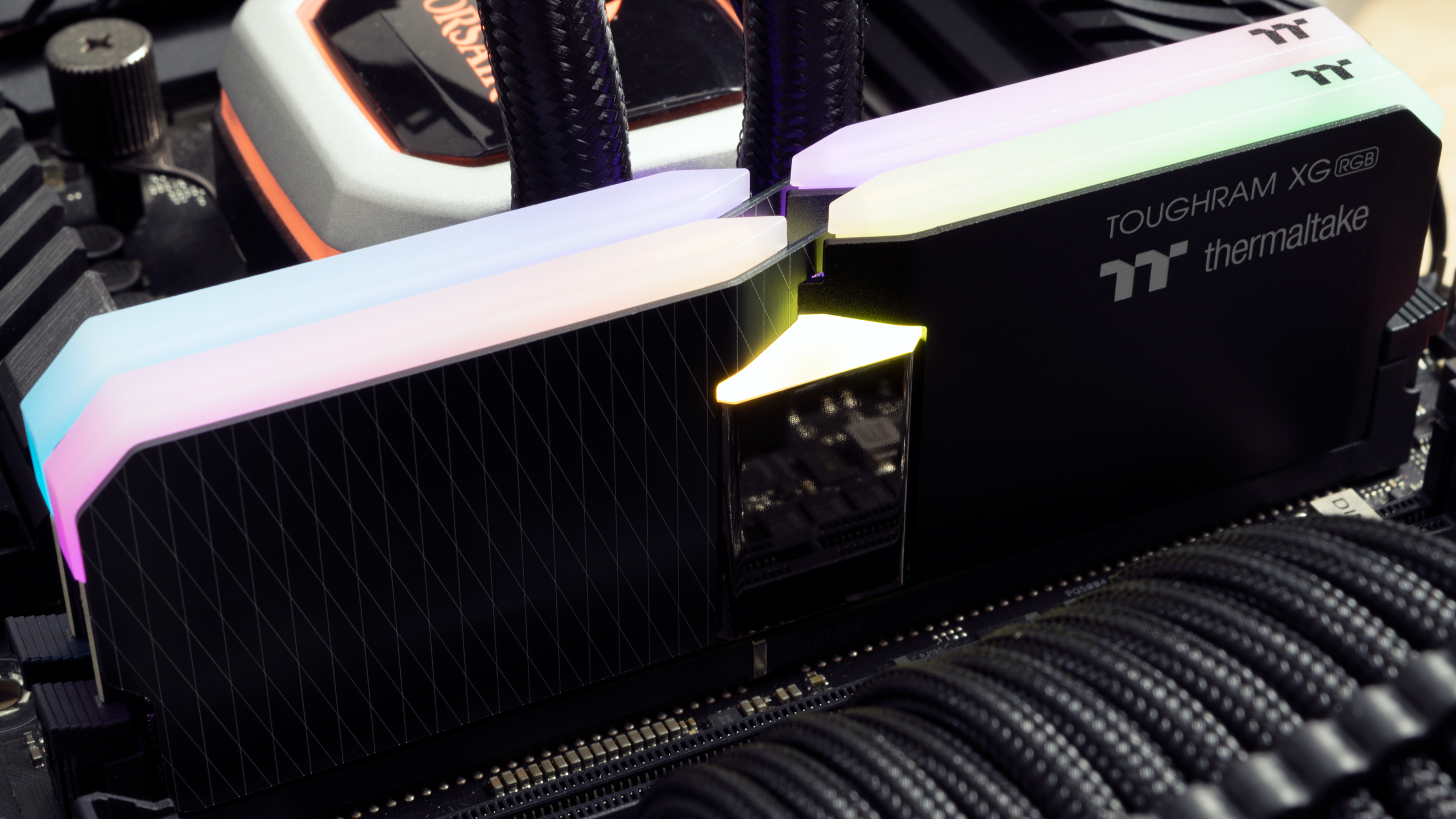
Thermaltake's ToughRAM XG RGB stands out thanks to its two-faceted exterior. The aluminum heat spreader is divided into two parts with a central chrome strip that brings the two designs together. The right portion exhibits a simple, black design, while the left portion consists of a more elaborate design with a metallic grey theme and a multi-line pattern.
The memory modules measure 48.24mm (1.9 inches) in height and feature a LED diffuser with 16 addressable LEDs divided in the middle. Each section features eight LEDs. Thermaltake boasts that users can create over 25 different illumination modes. In addition, the ToughRAM XG RGB plays nice with Asus Aura Sync, Gigabyte RGB Fusion 2.0, MSI Mystic Light Sync, and ASRock Polychrome RGB. If you're into Thermaltake's software, you can also control the memory's lighting with NeonMaker or TT RGB Plus.
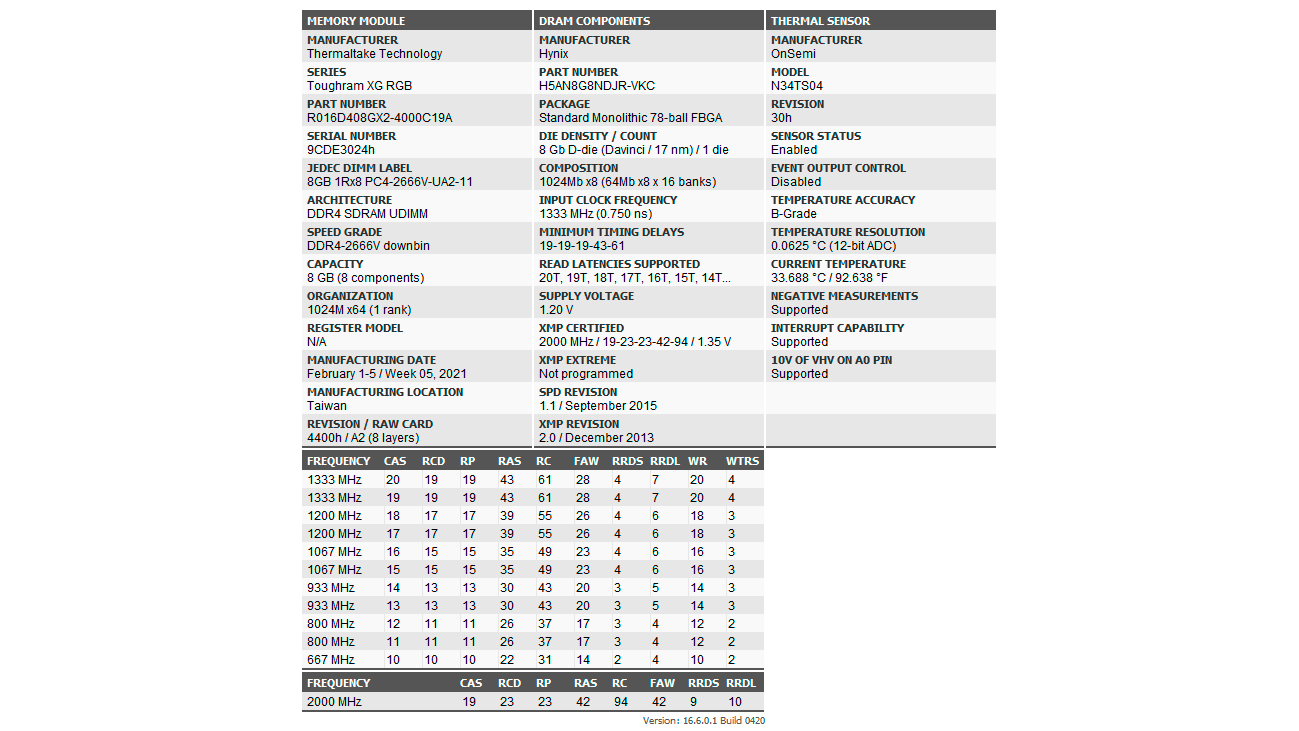

ToughRAM XG RGB memory modules flaunt a 10-layer PCB with a two-ounce copper inner layer and 10μ gold fingers. Both DDR4-4000 and DDR4-4600 memory kits come in a 16GB (2x8GB) configuration with single-rank memory modules. They also use the same Hynix D-die integrated circuits (ICs). More specifically, the DDR4-4000 memory kit makes use of the H5AN8G8NDJR-VKC IC, while the DDR4-4600 utilizes the H5AN8G8NDJR-XNC variant.
The kit defaults to 19-19-19-43 timings for the DDR4-4000 SKU and 22-22-22-52 timings for the DDR4-4600 SKU. The DDR4-4000 memory kit features XMP timings of 19-23-23-42 and requires a 1.45V DRAM voltage. The DDR4-4600 memory kit, on the other hand, has its timings at 19-26-26-45 and commands a DRAM voltage of 1.5V. For more on timings and frequency considerations, see our PC Memory 101 feature, as well as our How to Shop for RAM story.
Comparison Hardware
| Memory Kit | Part Number | Capacity | Data Rate | Primary Timings | Voltage | Warranty |
|---|---|---|---|---|---|---|
| Thermaltake ToughRAM XG RGB | R016D408GX2-4600C19A | 2 x 8GB | DDR4-4600 (XMP) | 19-26-26-45 (2T) | 1.50 | Lifetime |
| Thermaltake ToughRAM RGB | R009D408GX2-4600C19A | 2 x 8GB | DDR4-4600 (XMP) | 19-26-26-45 (2T) | 1.50 | Lifetime |
| Predator Apollo RGB | BL.9BWWR.255 | 2 x 8GB | DDR4-4500 (XMP) | 19-19-19-39 (2T) | 1.45 | Lifetime |
| GeIL Orion RGB AMD Edition | GAOSR416GB4400C18ADC | 2 x 8GB | DDR4-4400 (XMP) | 18-24-24-44 (2T) | 1.45 | Lifetime |
| Patriot Viper 4 Blackout | PVB416G440C8K | 2 x 8GB | DDR4-4400 (XMP) | 18-26-26-46 (2T) | 1.45 | Lifetime |
| TeamGroup T-Force Dark Z FPS | TDZFD416G4000HC16CDC01 | 2 x 8GB | DDR4-4000 (XMP) | 16-18-18-38 (2T) | 1.45 | Lifetime |
| Klevv Cras XR | KD48GU880-40B190Z | 2 x 8GB | DDR4-4000 (XMP) | 19-25-25-45 (2T) | 1.40 | Lifetime |
| Thermaltake ToughRAM XG RGB | R016D408GX2-4000C19A | 2 x 8GB | DDR4-4000 (XMP) | 19-26-26-45 (2T) | 1.45 | Lifetime |
| TeamGroup T-Force Xtreem ARGB | TF10D416G3600HC14CDC01 | 2 x 8GB | DDR4-3600 (XMP) | 14-15-15-35 (2T) | 1.45 | Lifetime |
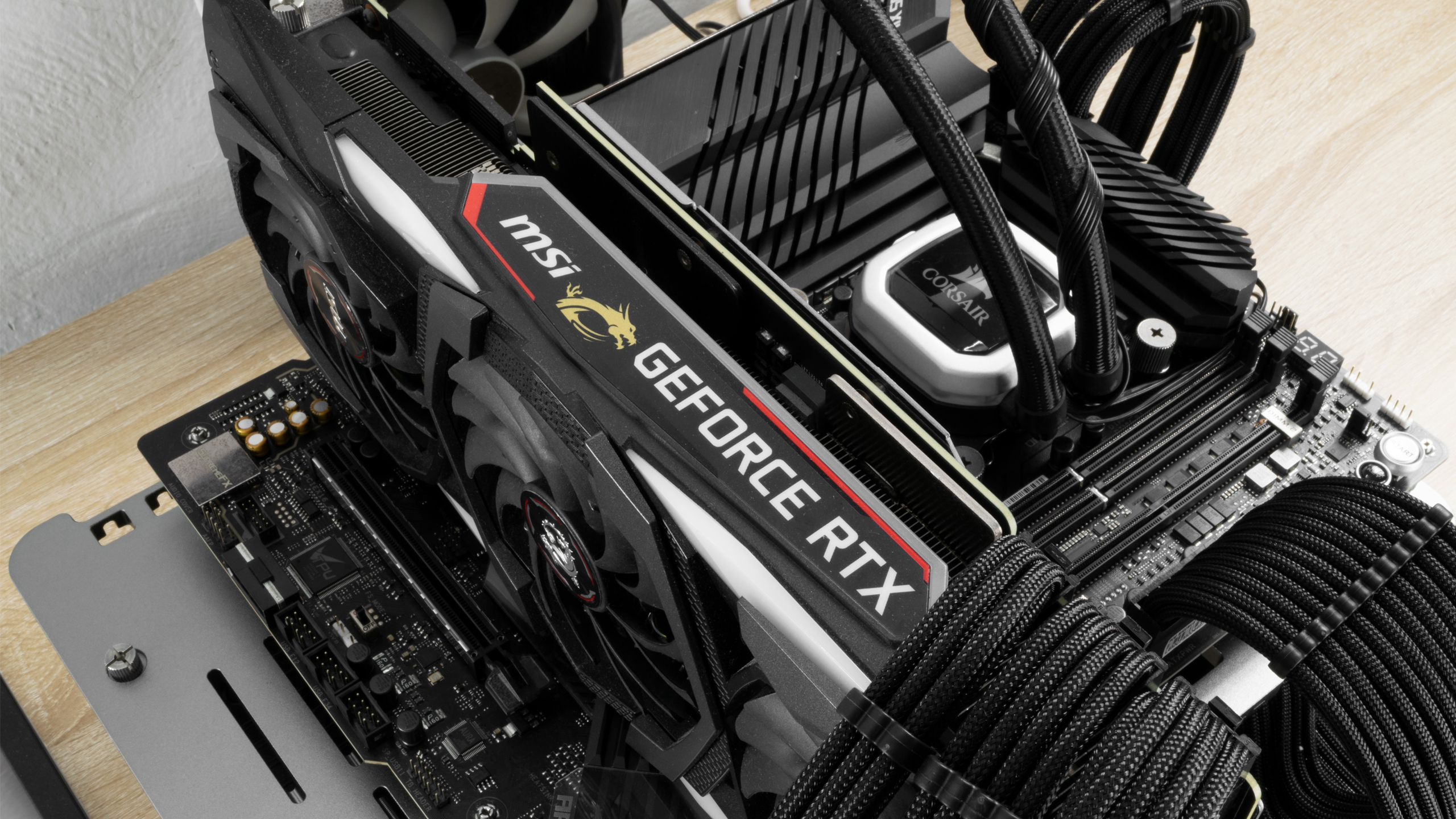
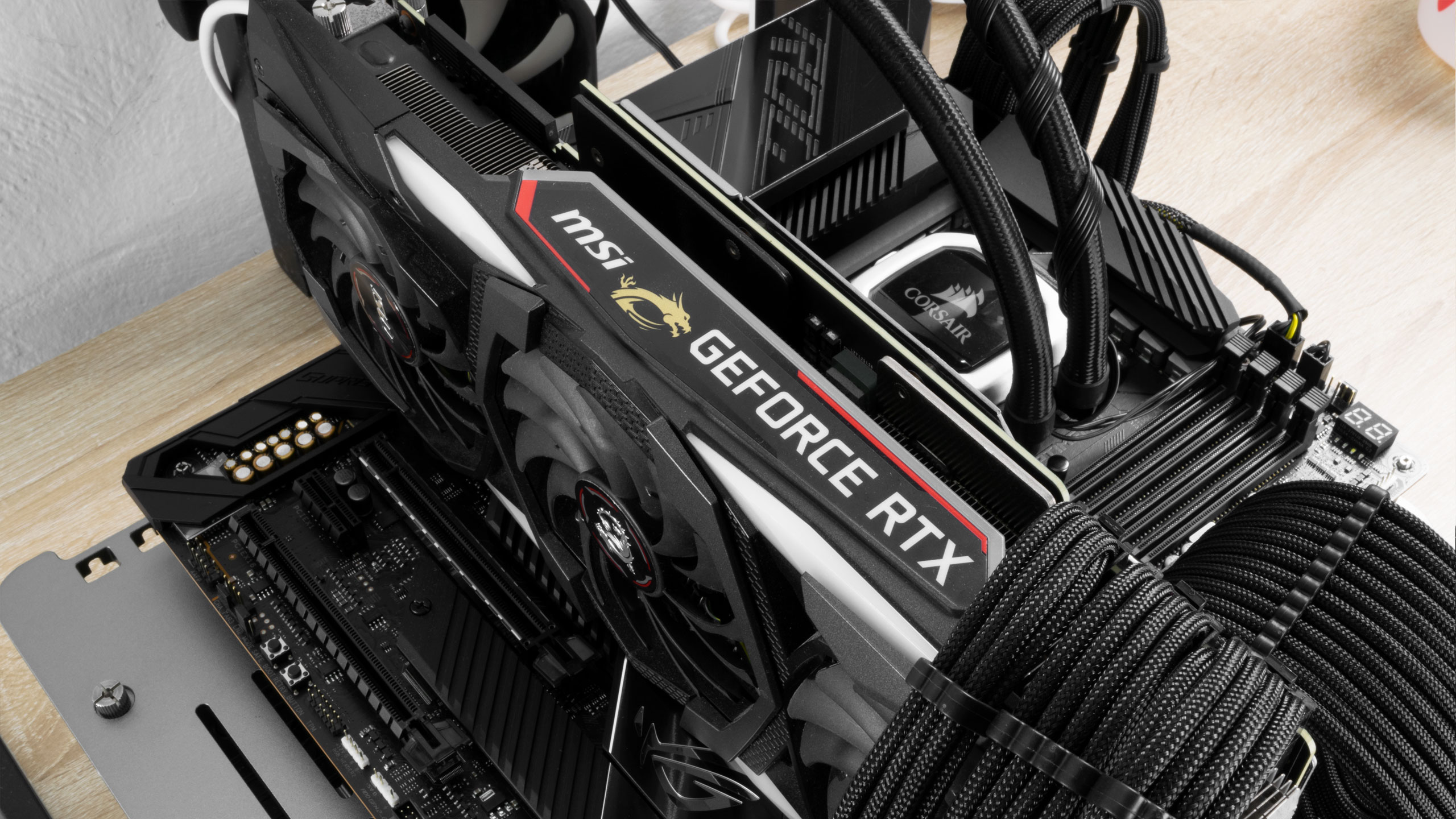
Our Intel-based system uses an Intel Core i9-10900K processor and Asus ROG Maximus XII Apex. The motherboard runs on the 0901 firmware. On the opposite side, our AMD testbed is based on the AMD Ryzen 9 5900X and the Asus ROG Crosshair VIII Dark Hero. The latter is on the 3501 firmware. For graphics, we turned to the MSI GeForce RTX 2080 Ti Gaming Trio to take care of the gaming RAM benchmarks.
| Header Cell - Column 0 | Intel System | AMD System |
|---|---|---|
| Processor | Intel Core i9-10900K | AMD Ryzen 9 5900X |
| Motherboard | Asus ROG Maximus XII Apex | Asus ROG Crosshair VIII Dark Hero |
| Graphics Card | MSI GeForce RTX 2080 Ti Gaming X Trio | MSI GeForce RTX 2080 Ti Gaming X Trio |
| Storage | Crucial MX500 500GB, 2TB | Crucial MX500 500GB, 2TB |
| Cooling | Corsair Hydro H115i Pro | Corsair Hydro H115i Pro |
| Power Supply | Corsair RM650x 650W | Corsair RM650x 650W |
| Case | Streacom BC1 | Streacom BC1 |
Intel Performance
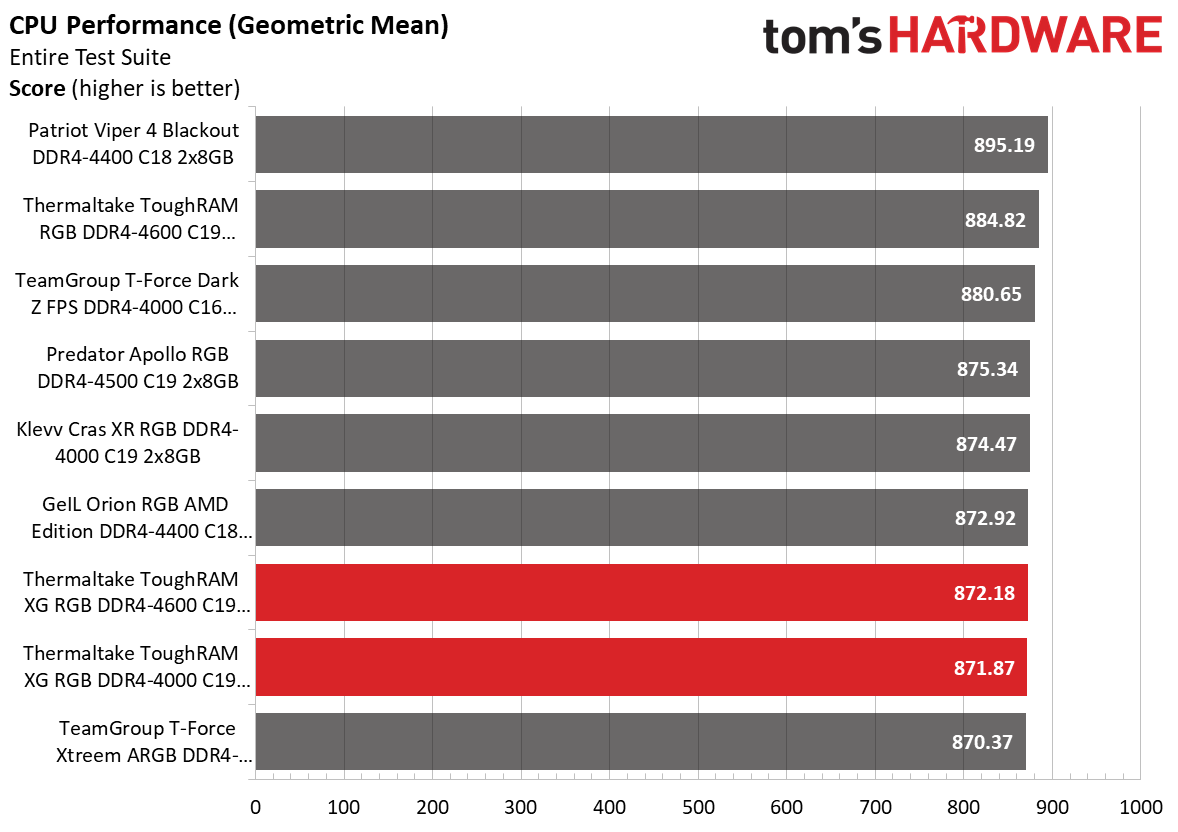

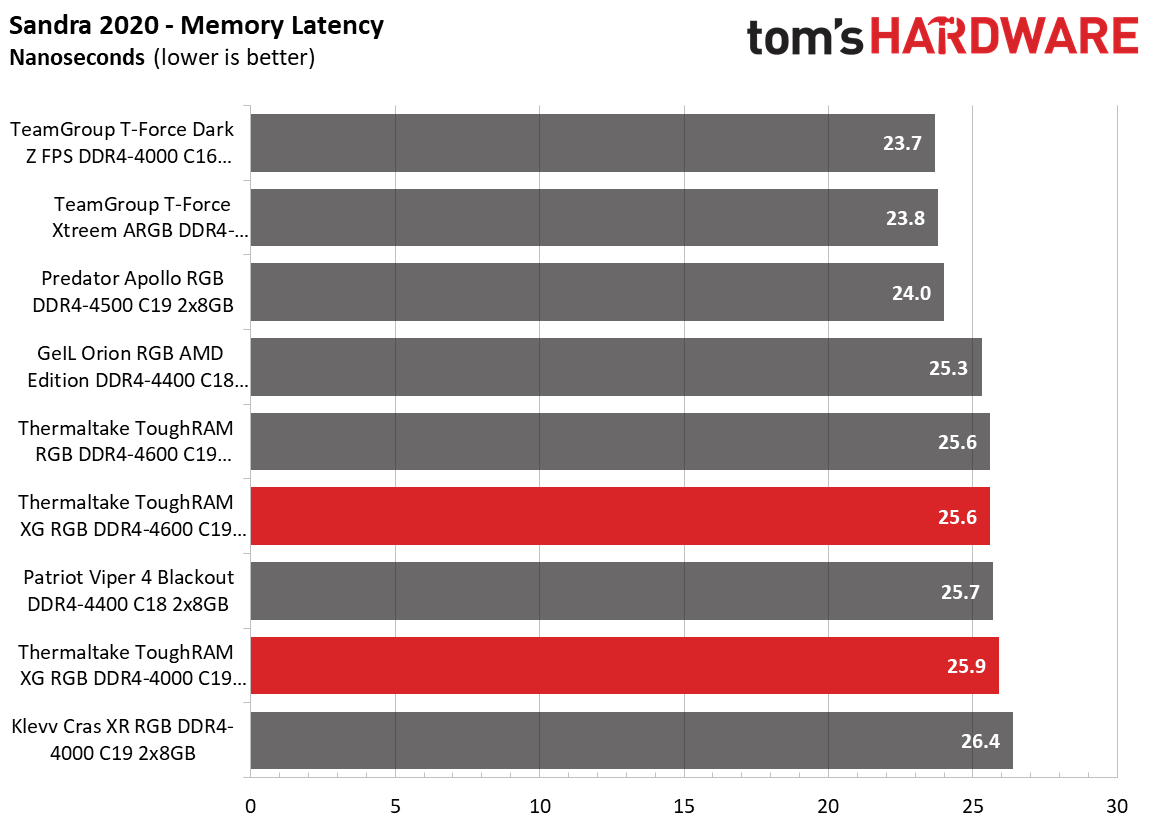

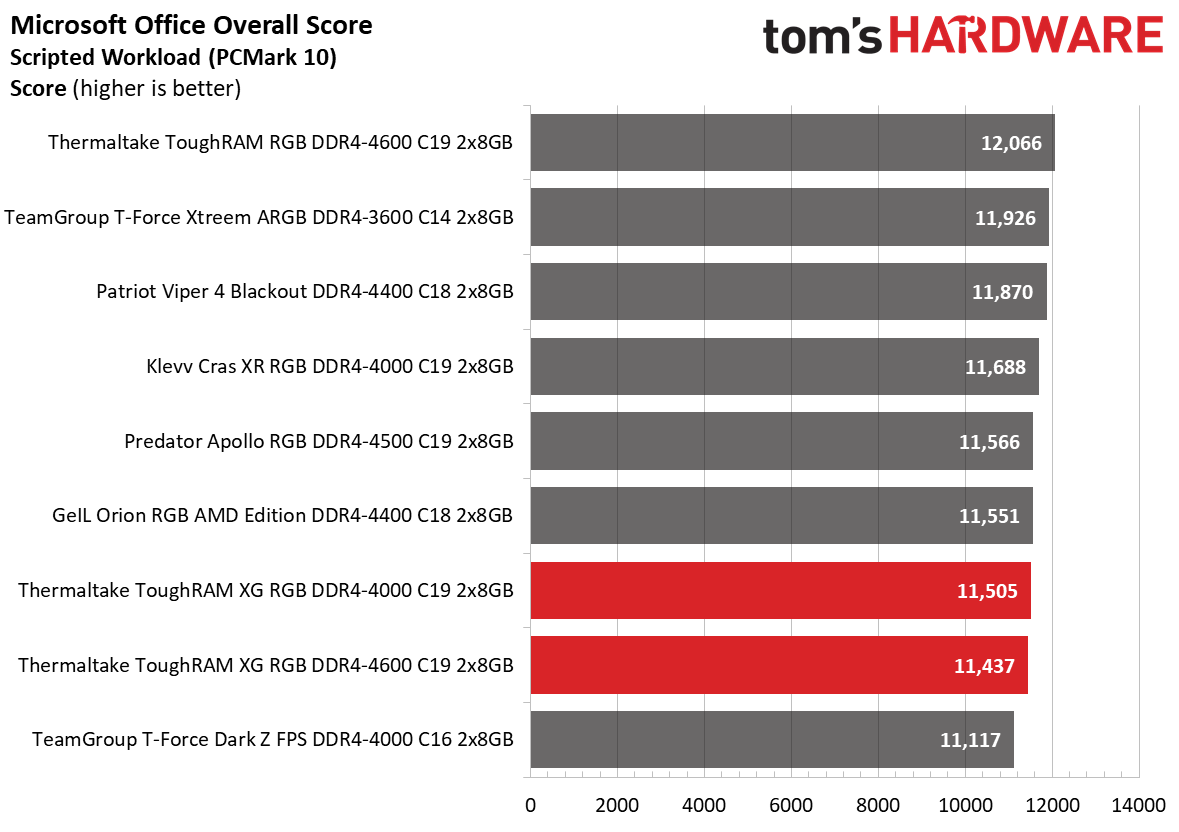
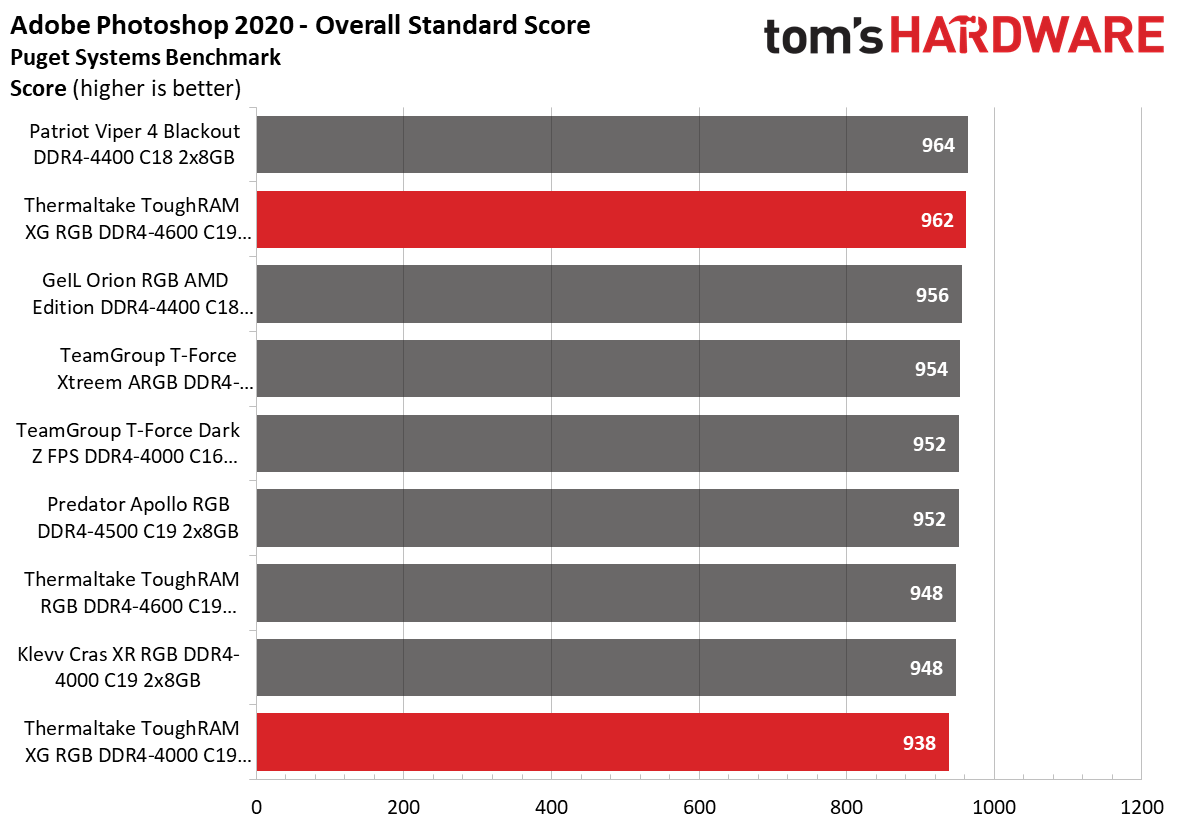
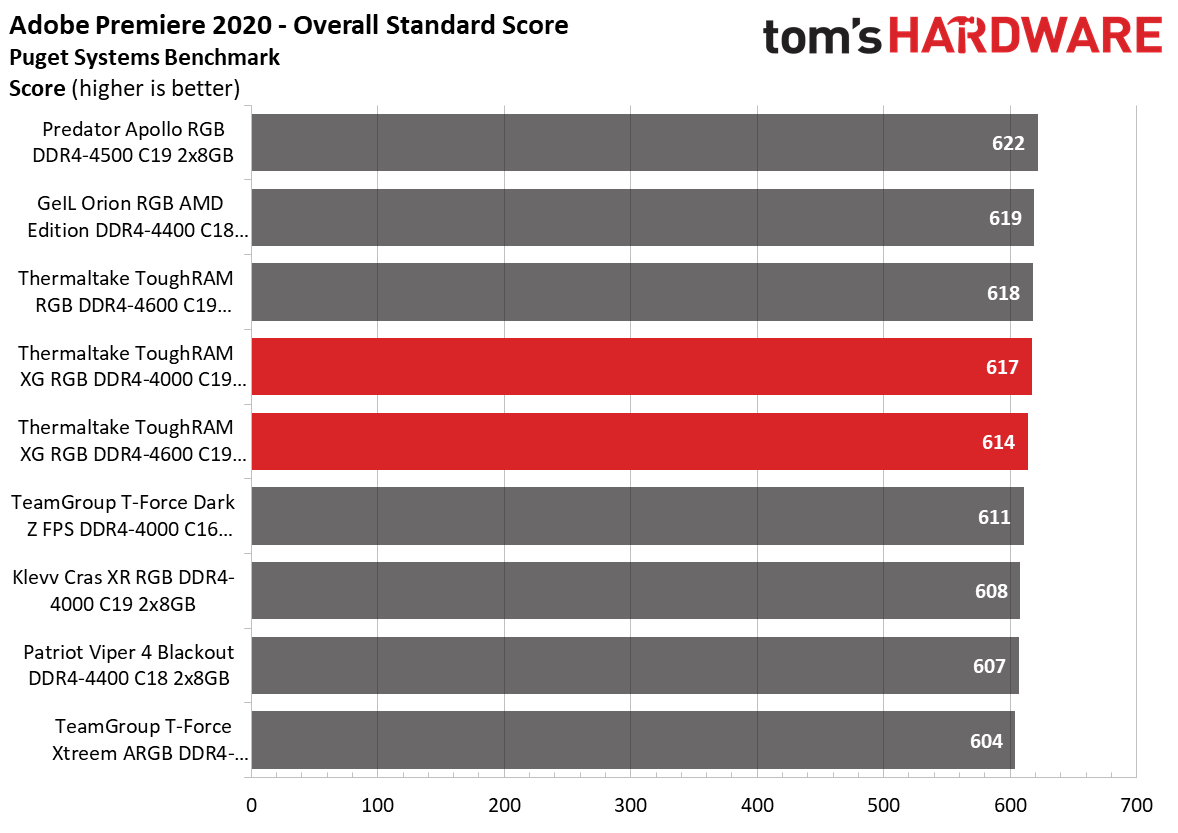

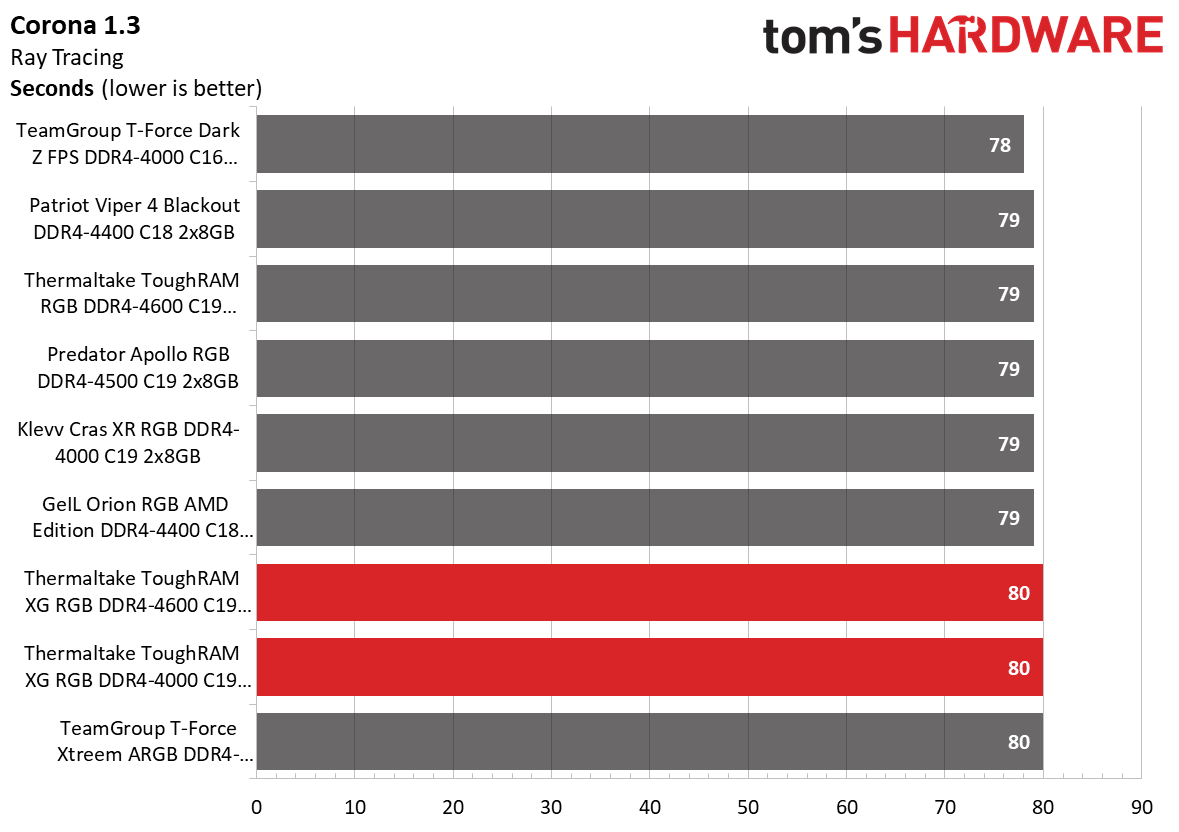
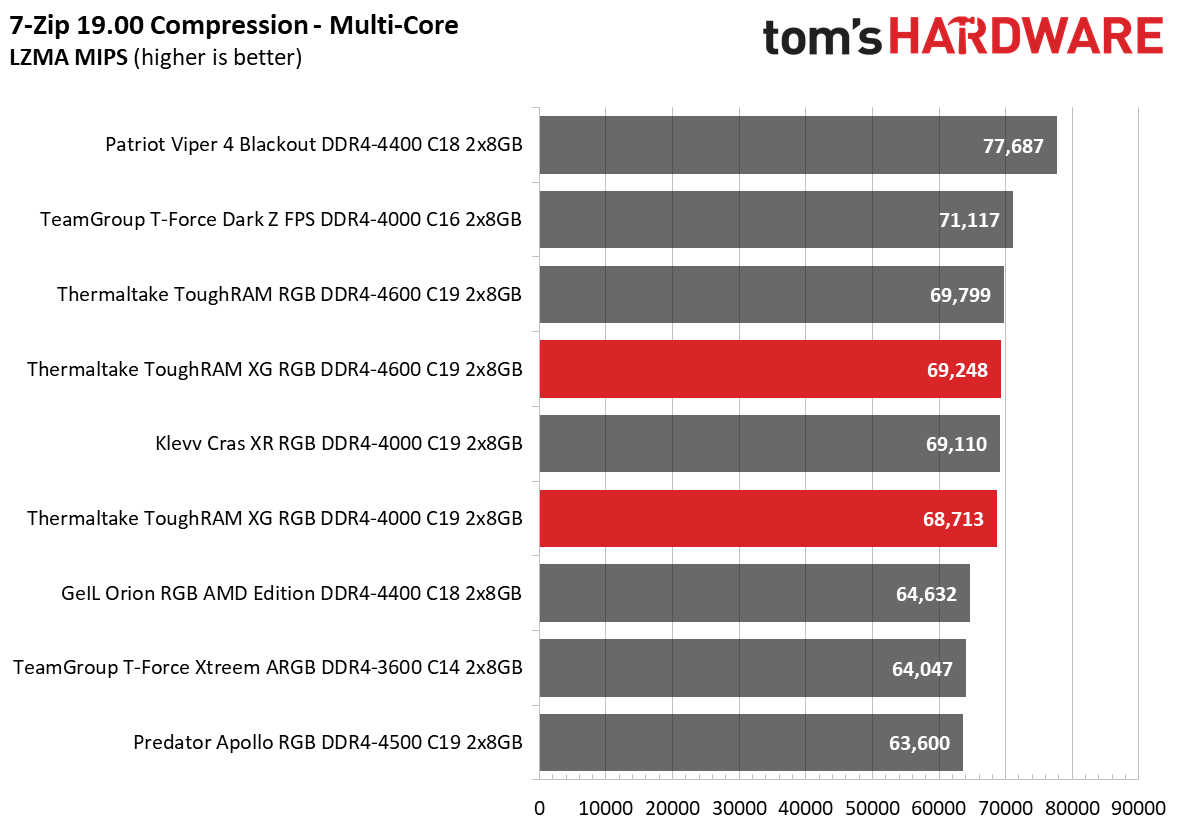
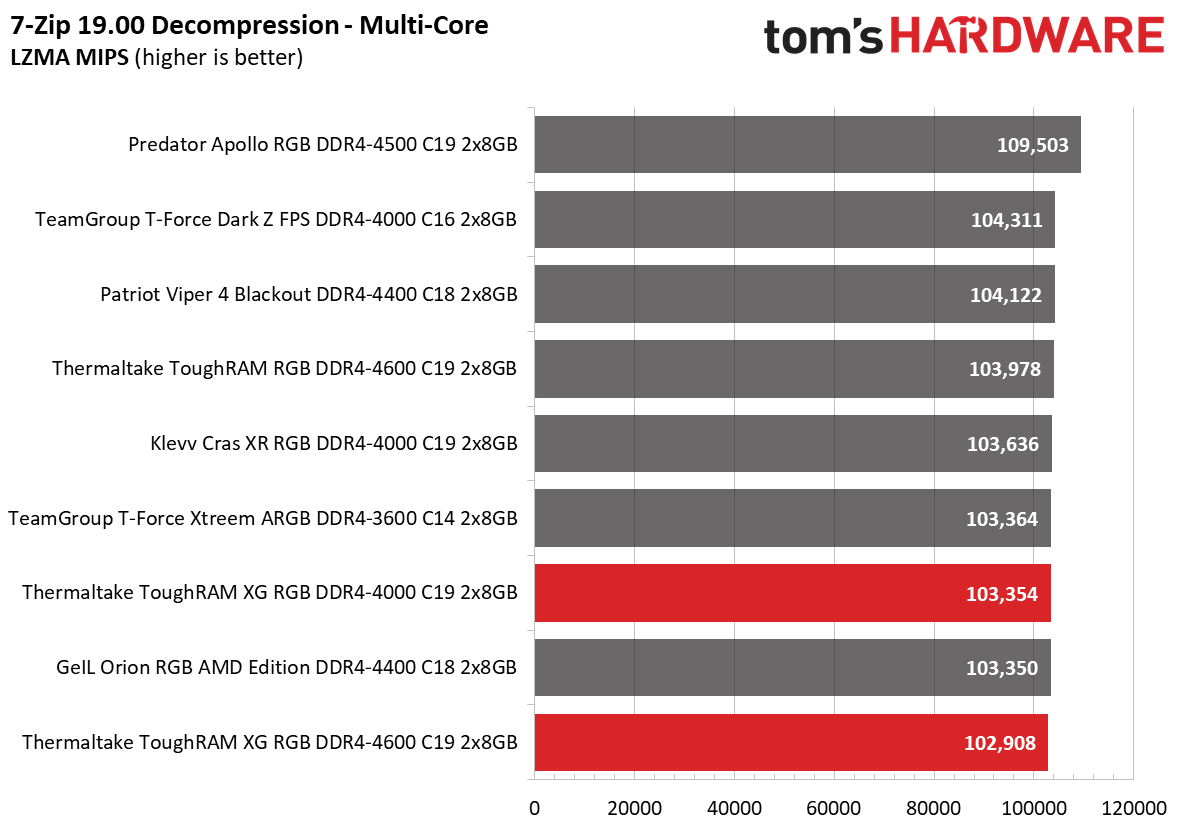
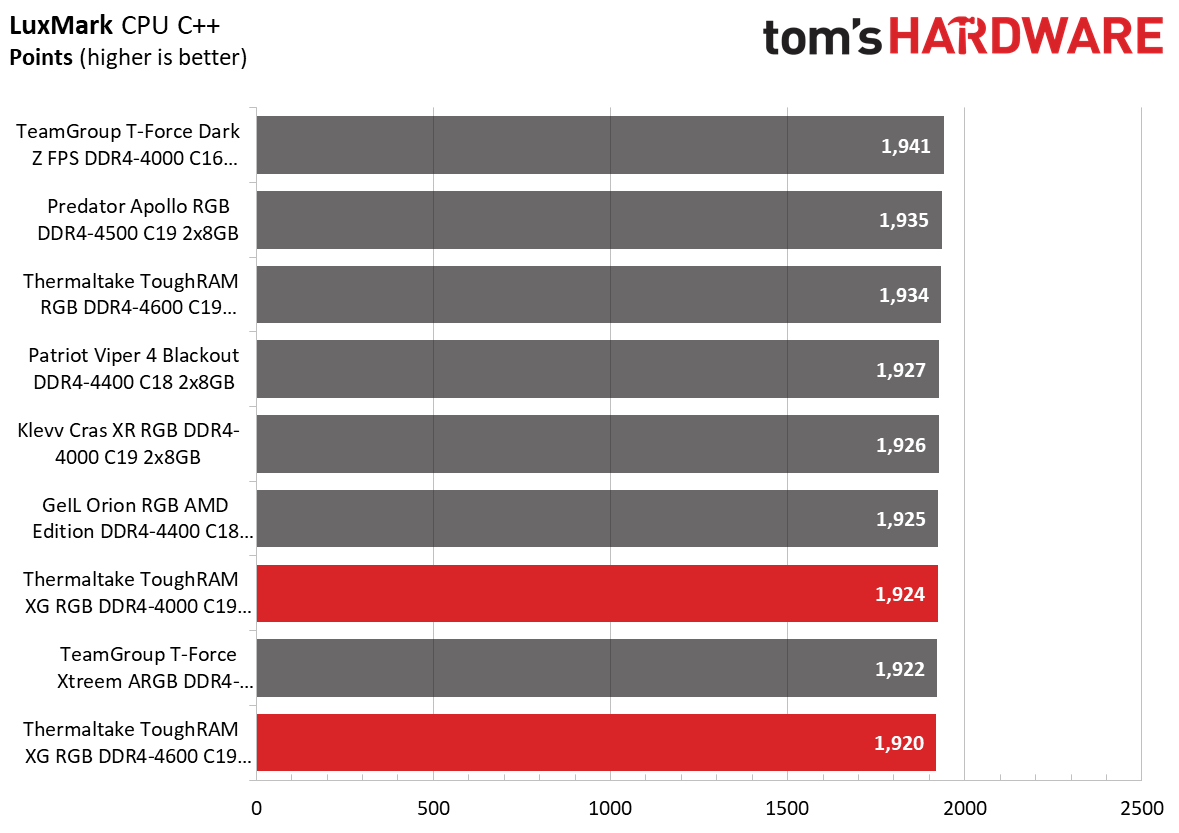
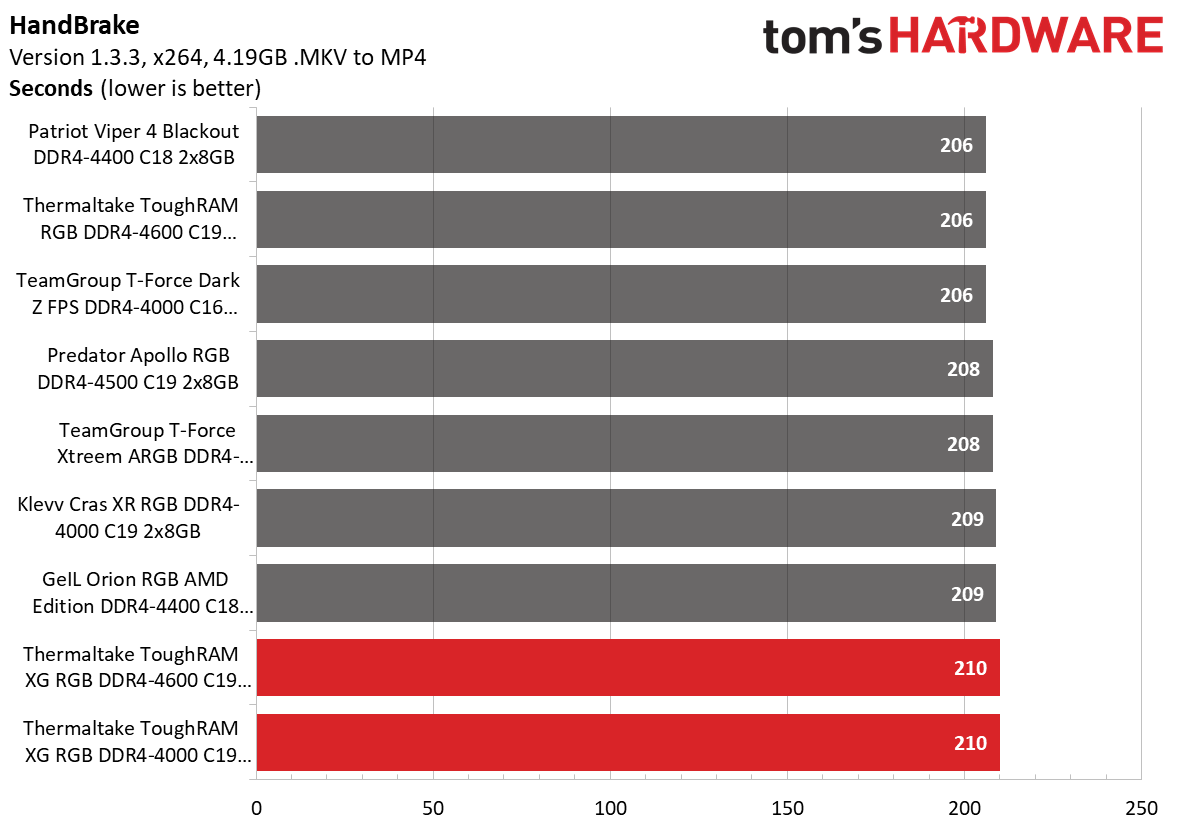
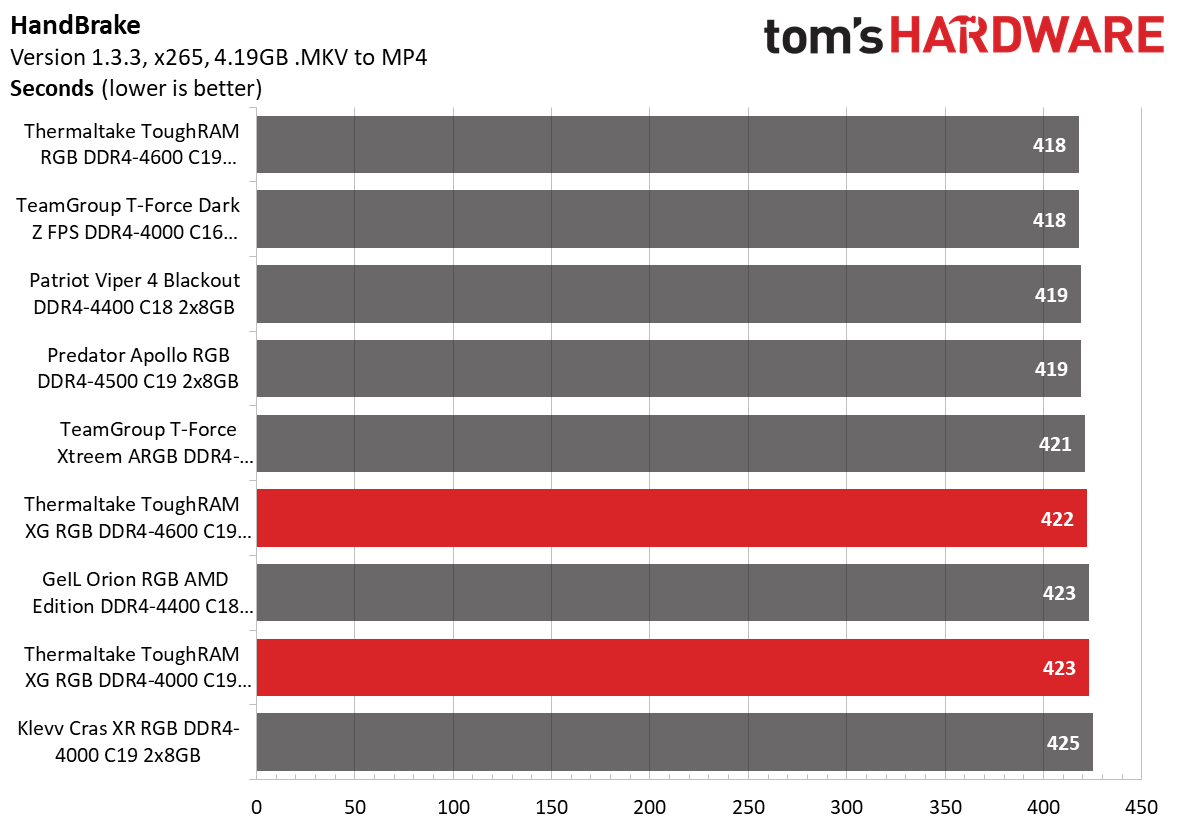

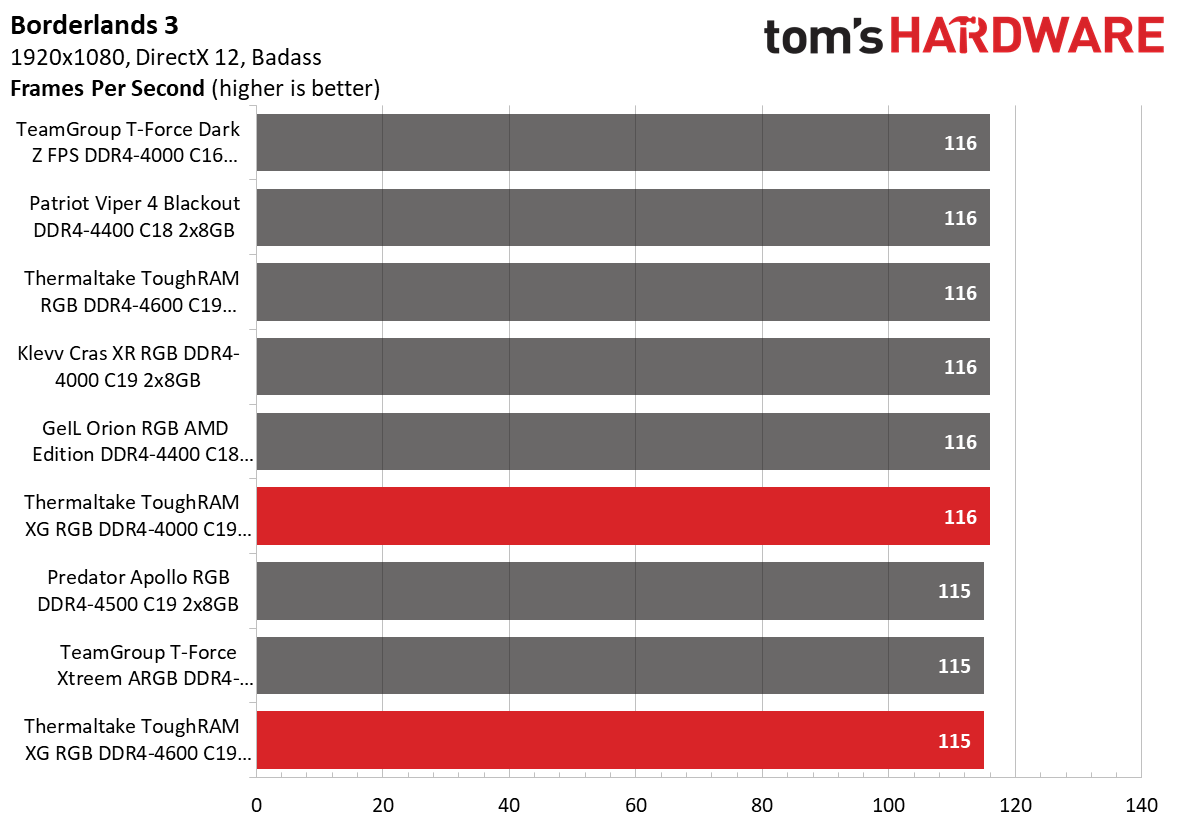


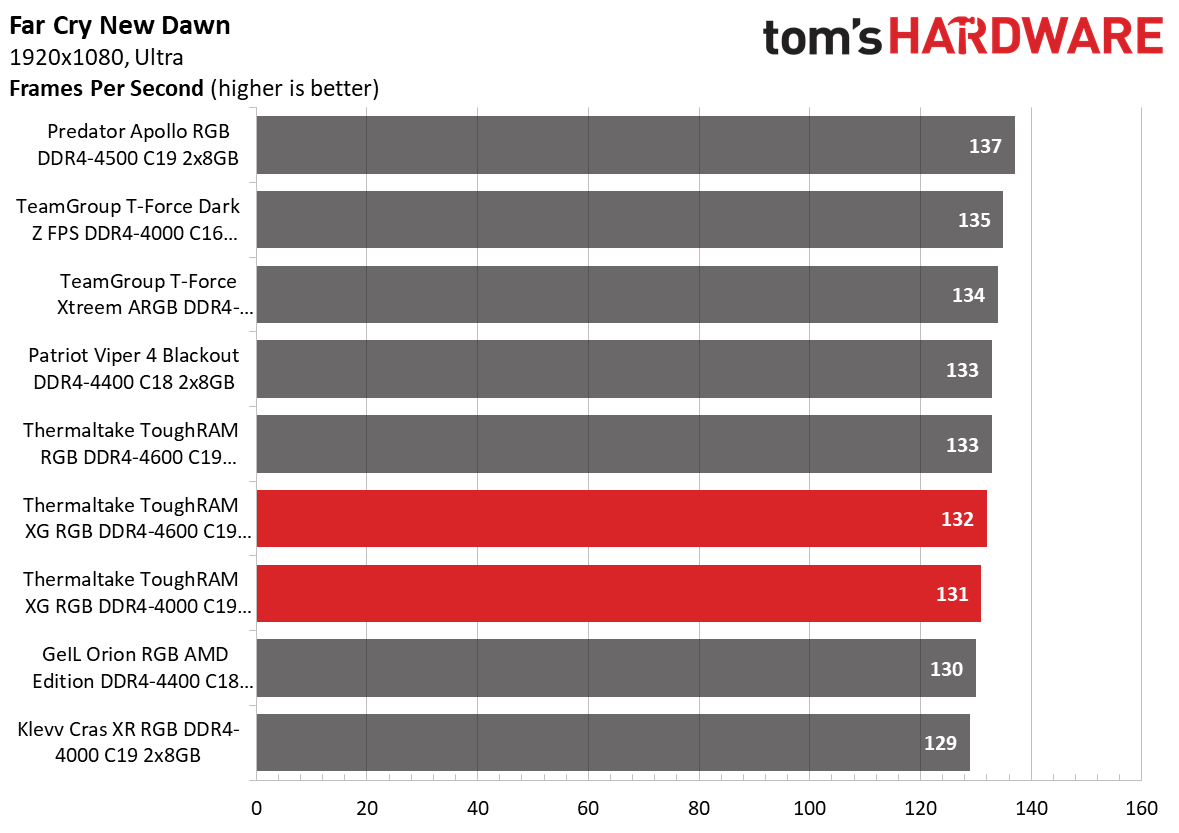
The Thermaltake ToughRAM XG RGB DDR4-4000 and DDR4-4600 memory kits showed very close application performance in the cumulative charts. The latter was slightly faster in gaming performance, but the margins were very small.
Get Tom's Hardware's best news and in-depth reviews, straight to your inbox.
AMD Performance
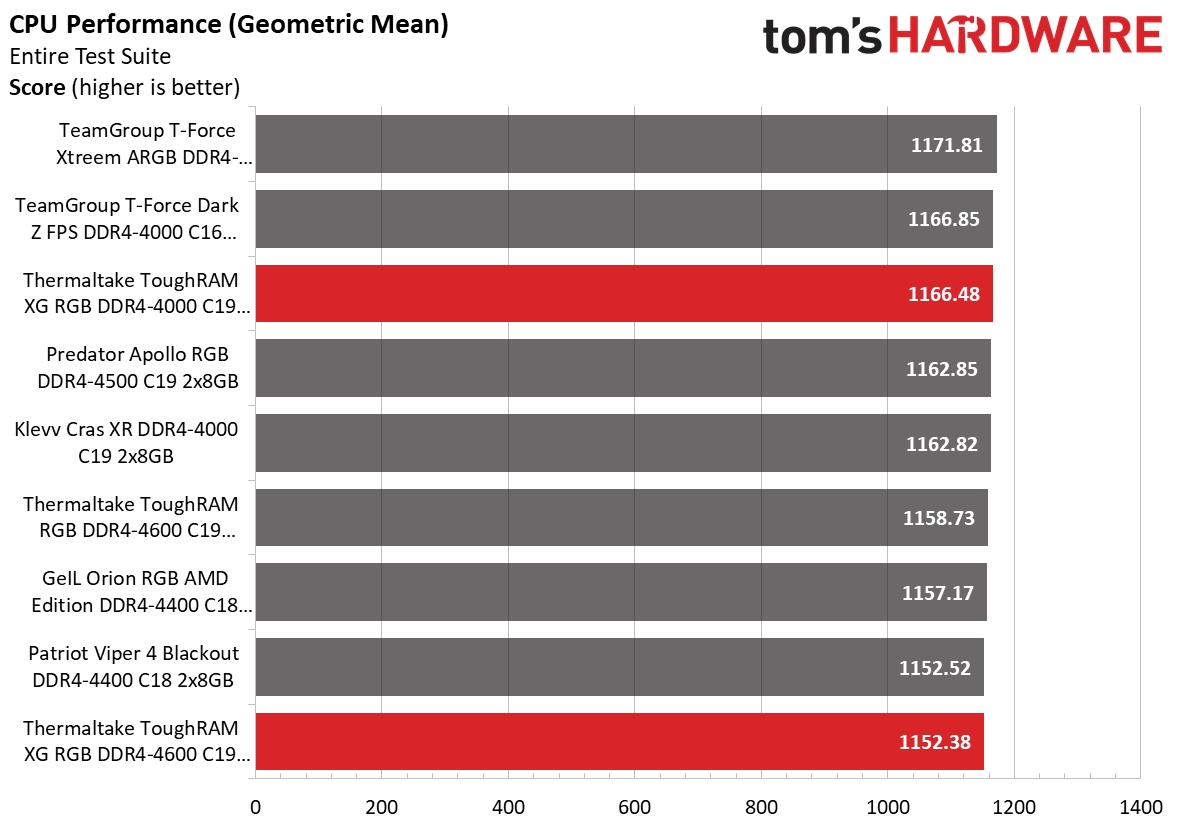
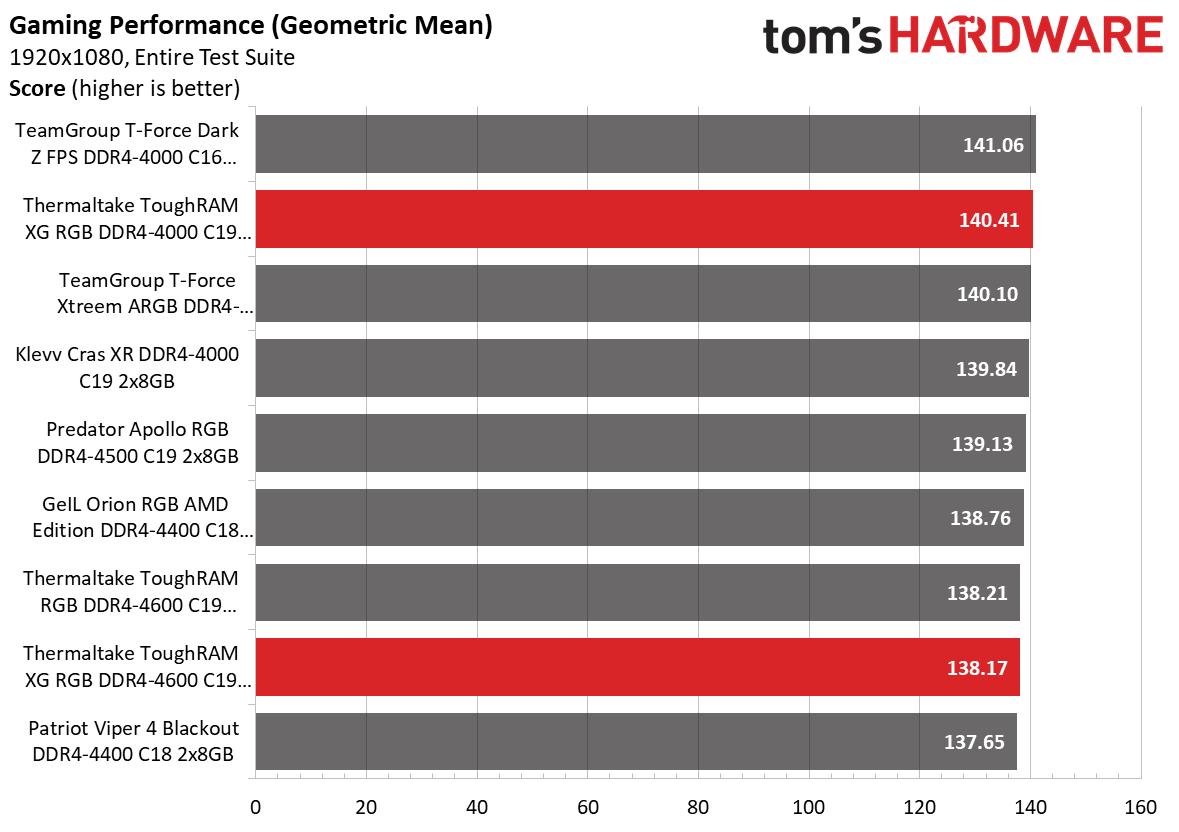
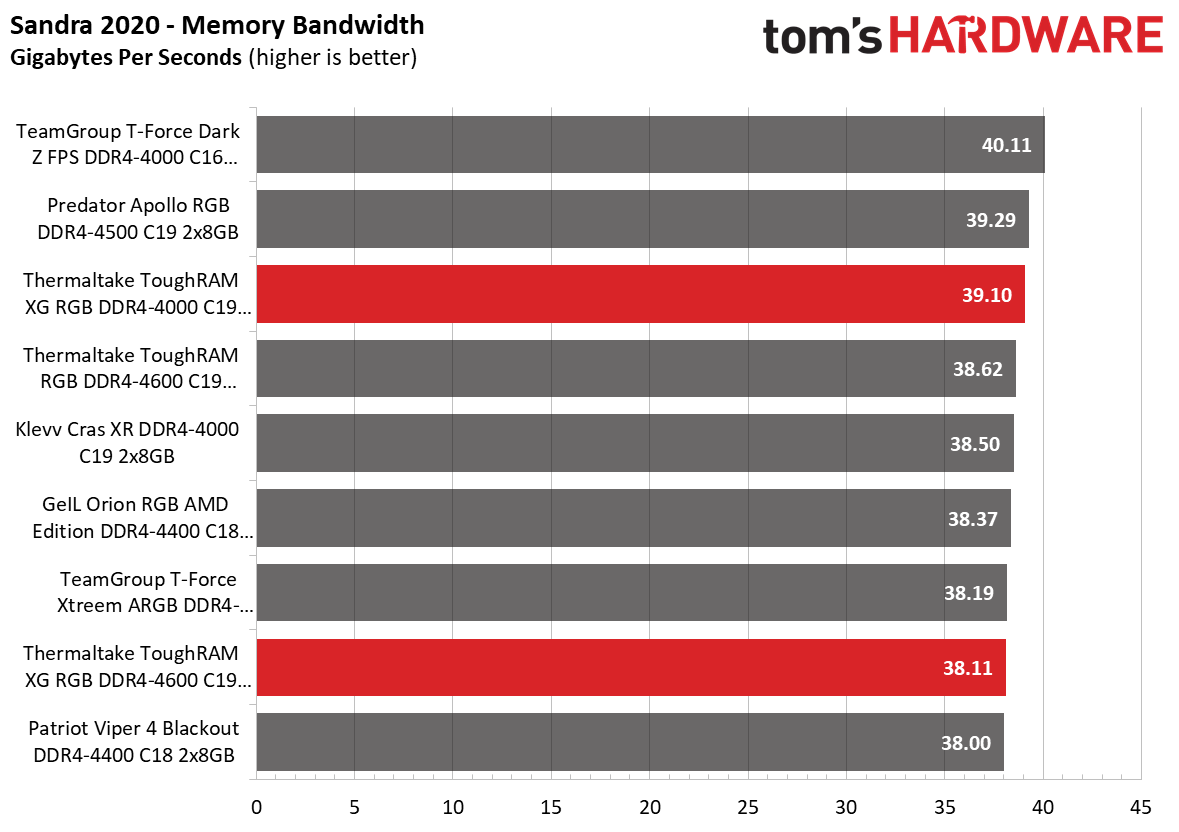
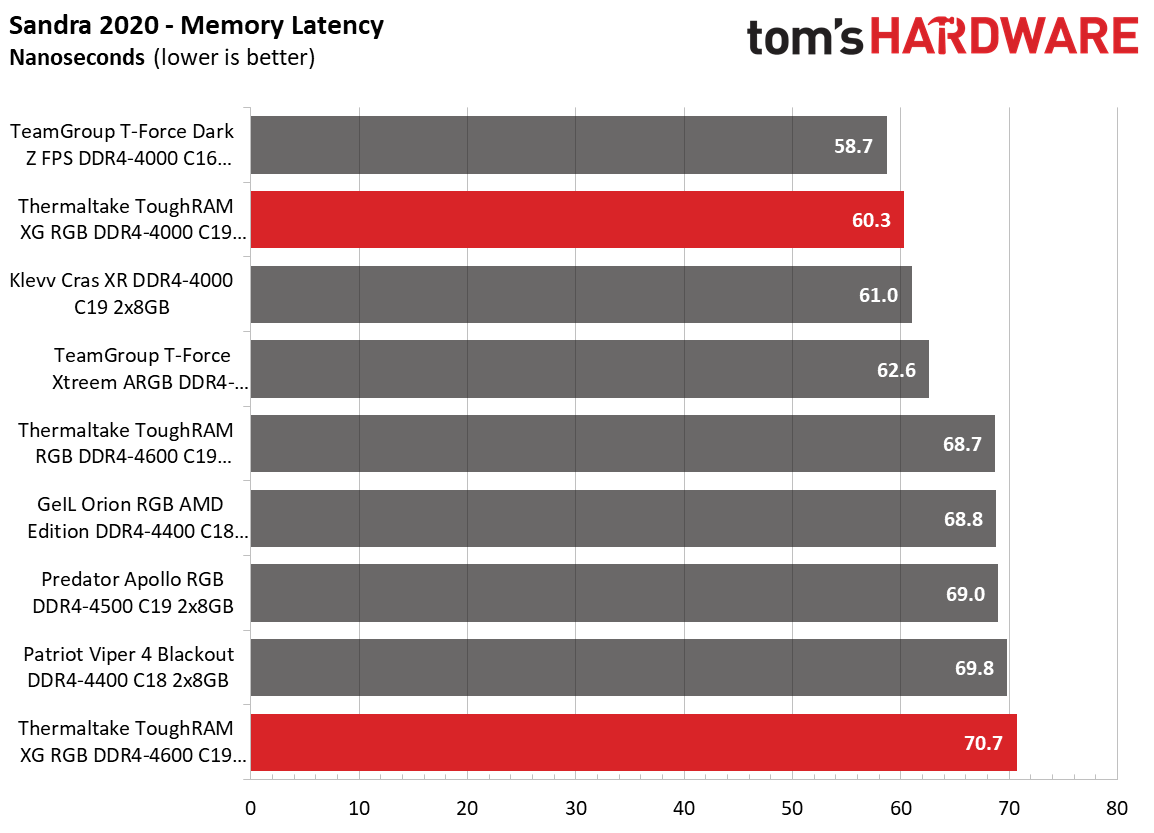
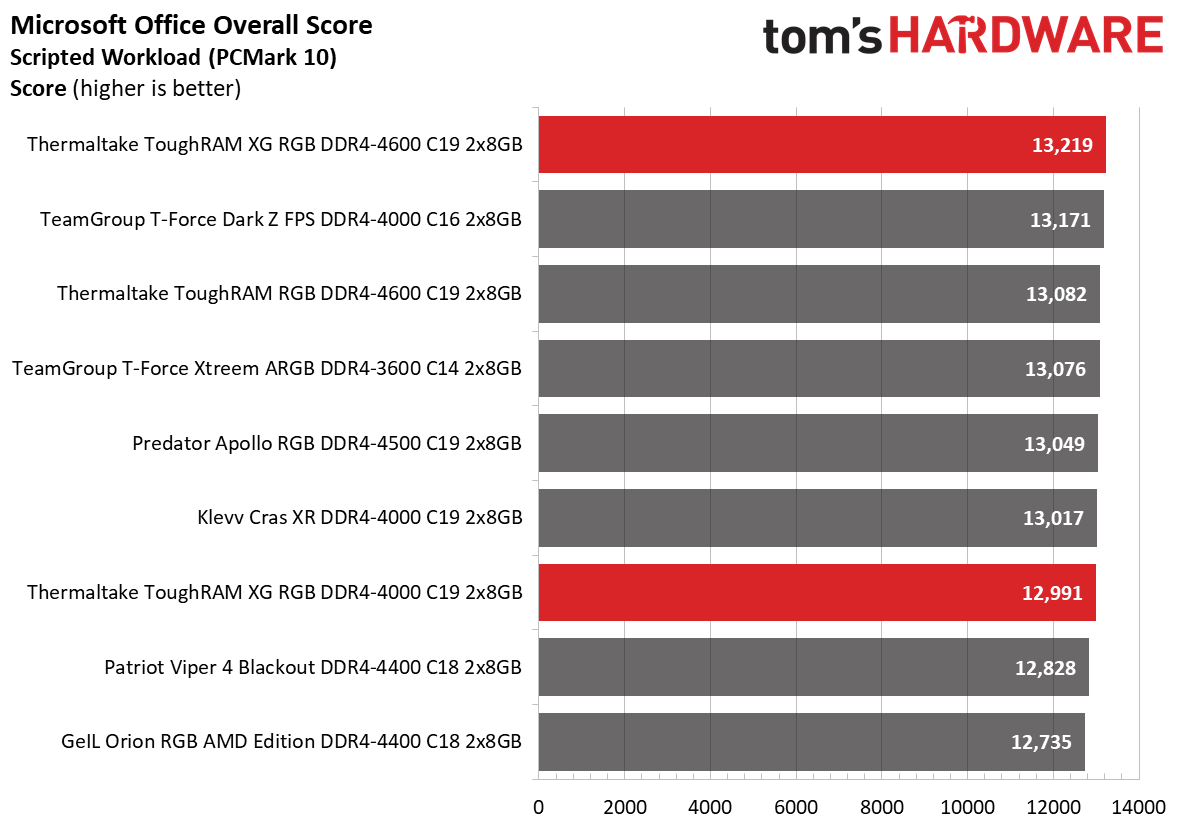
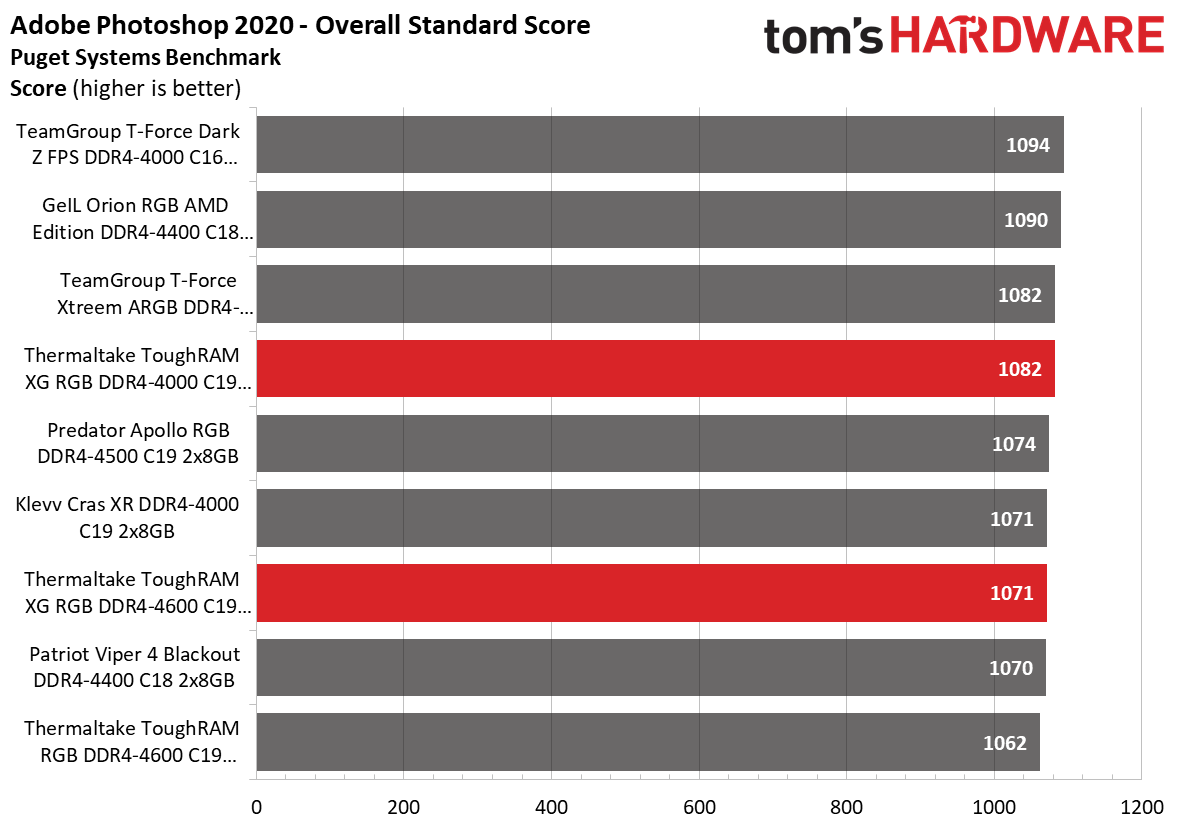
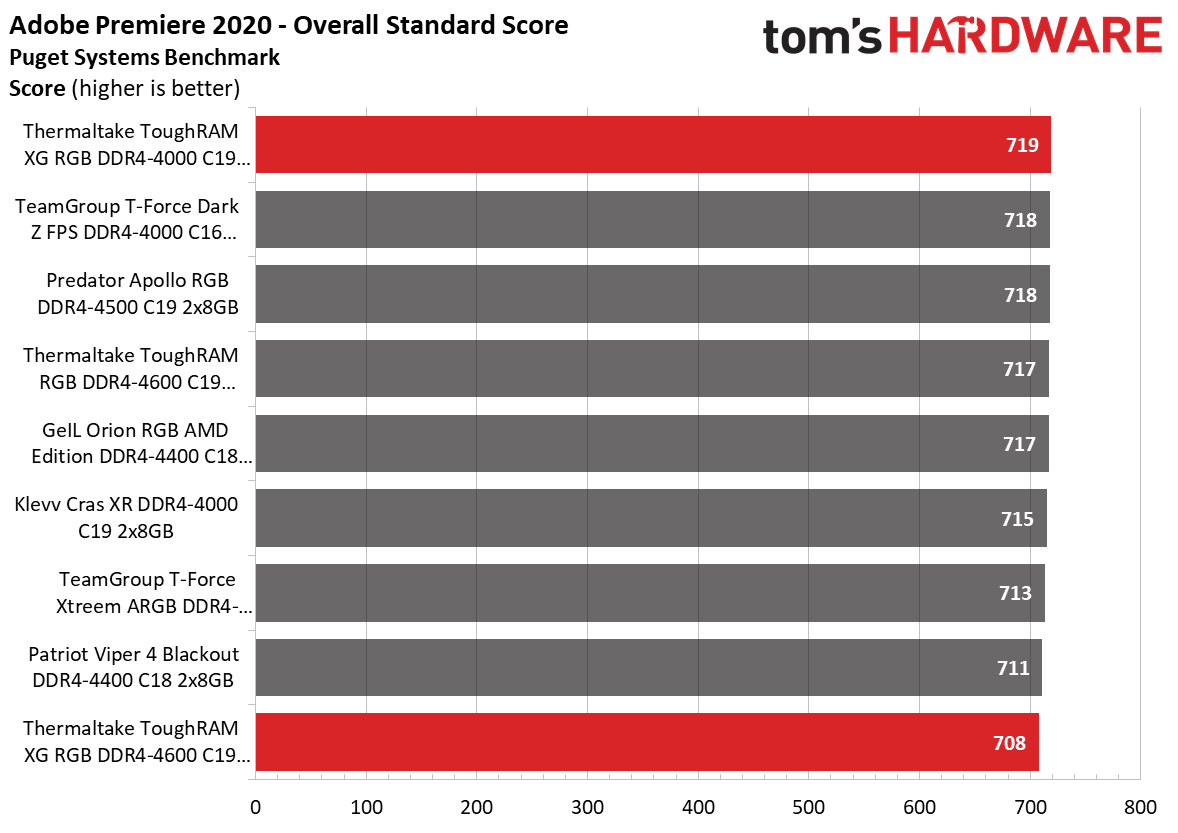
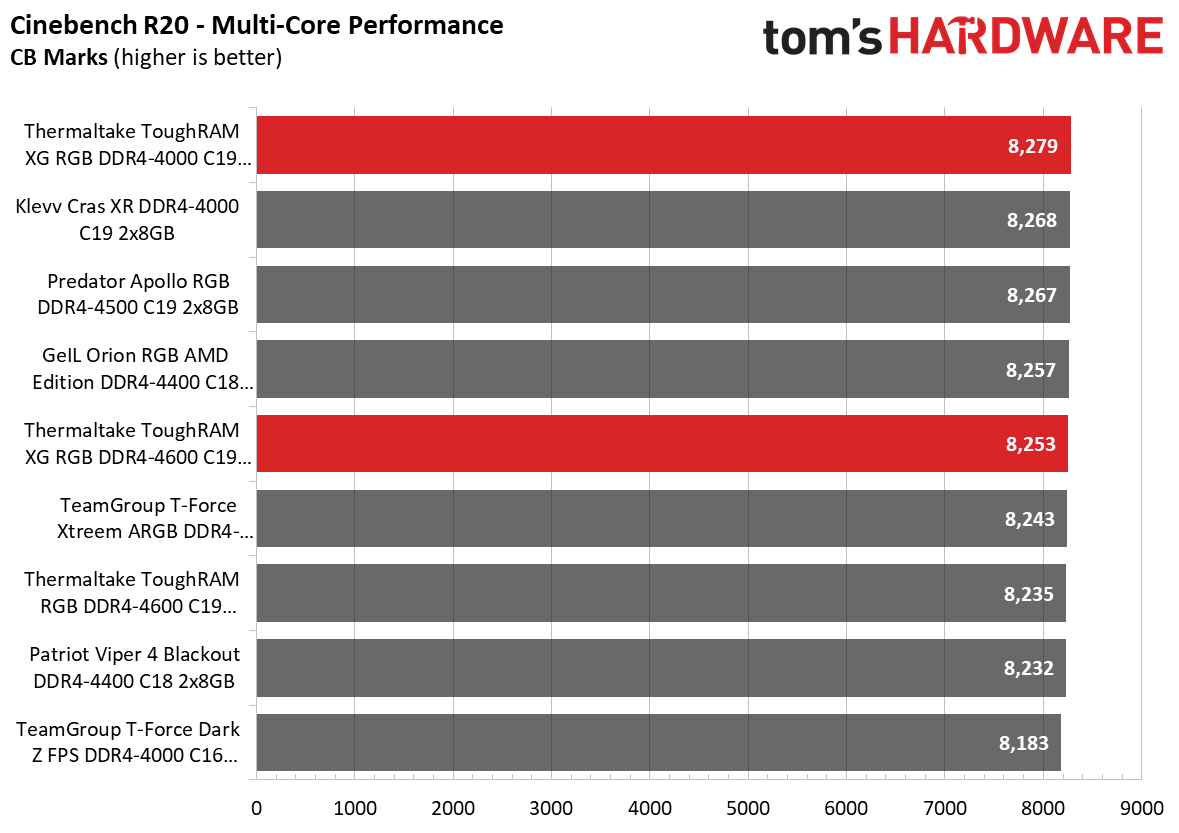
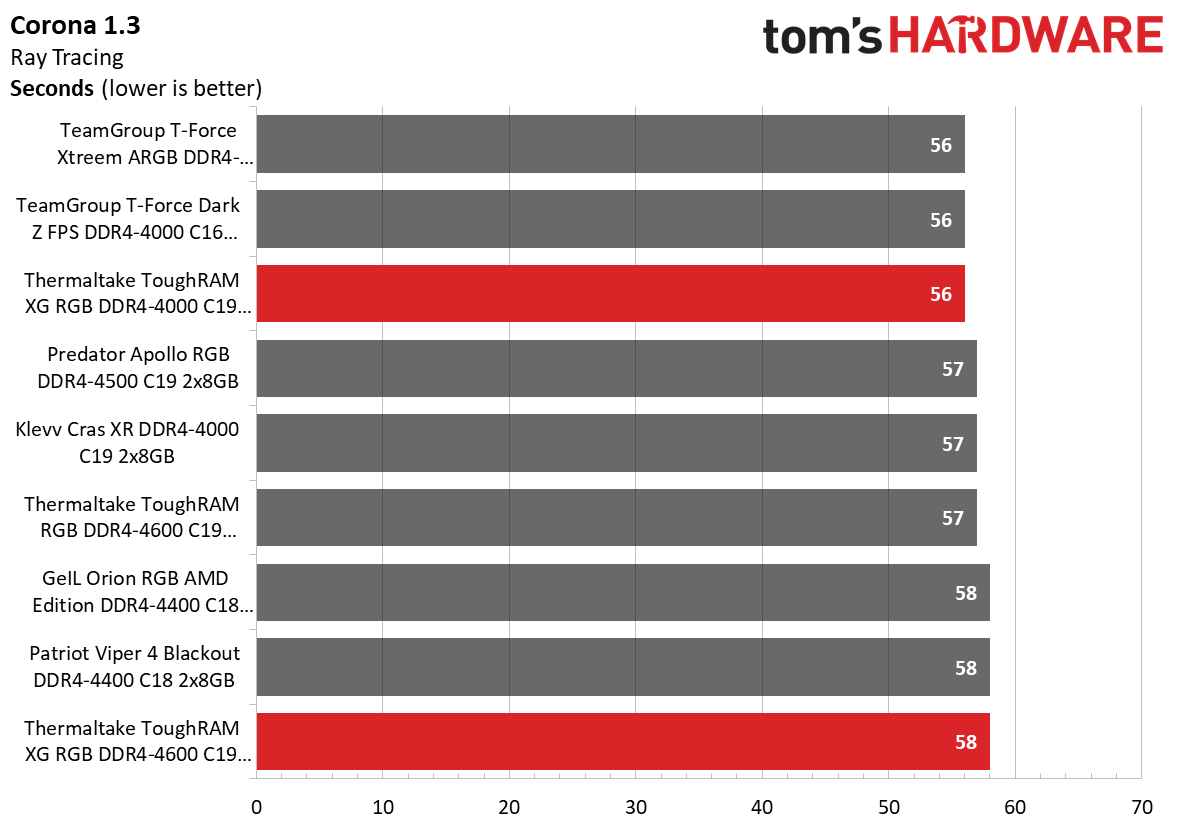
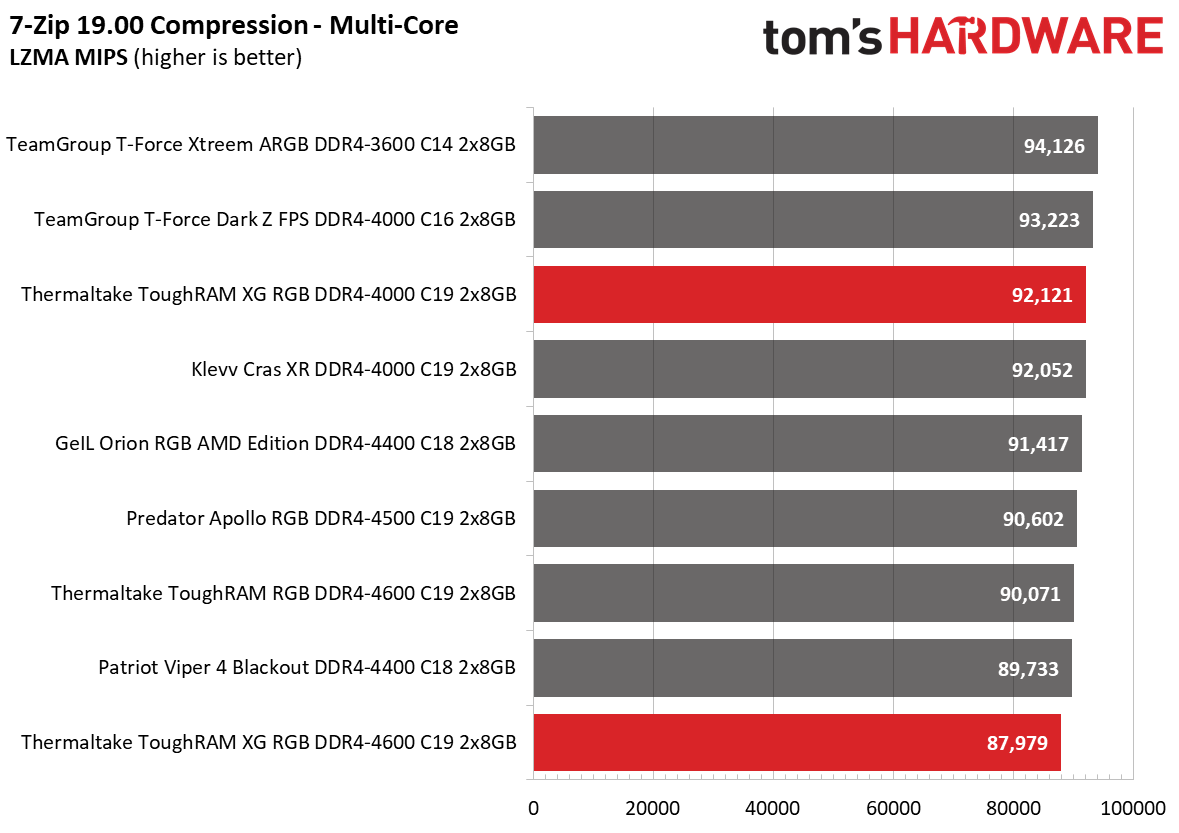

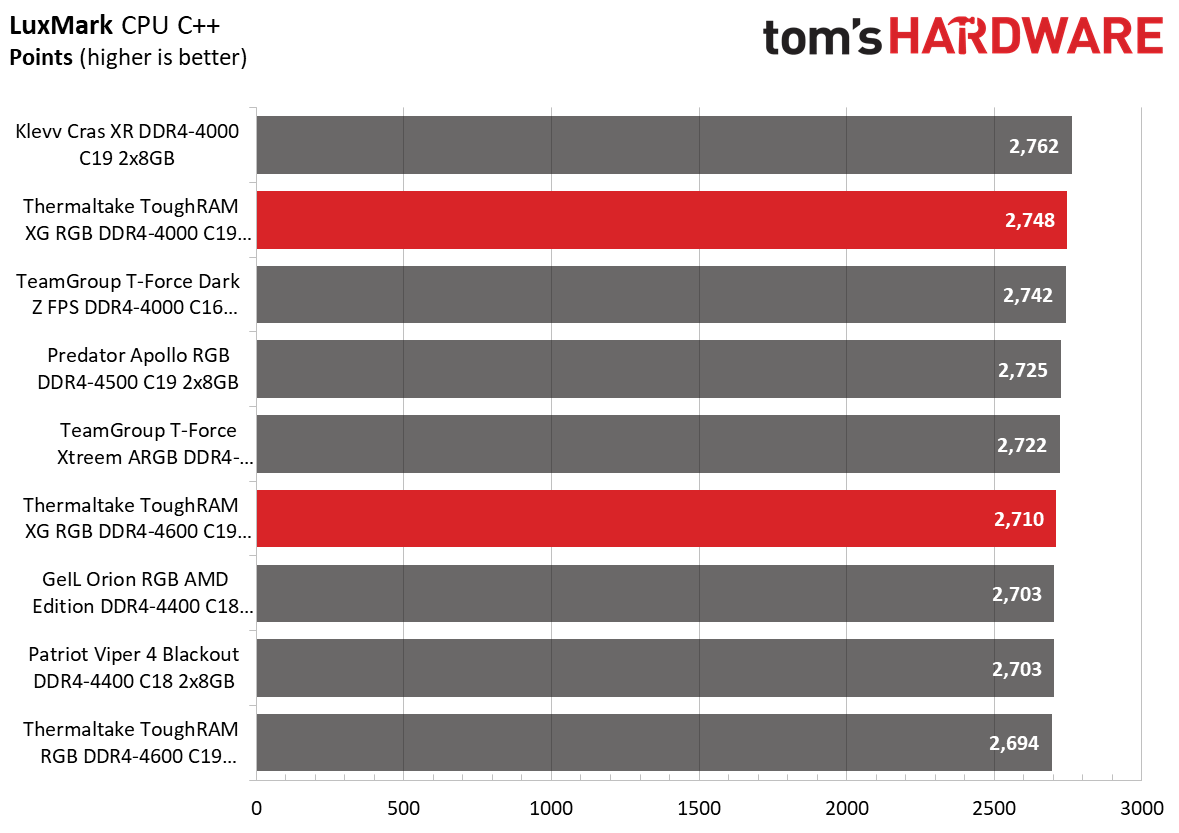

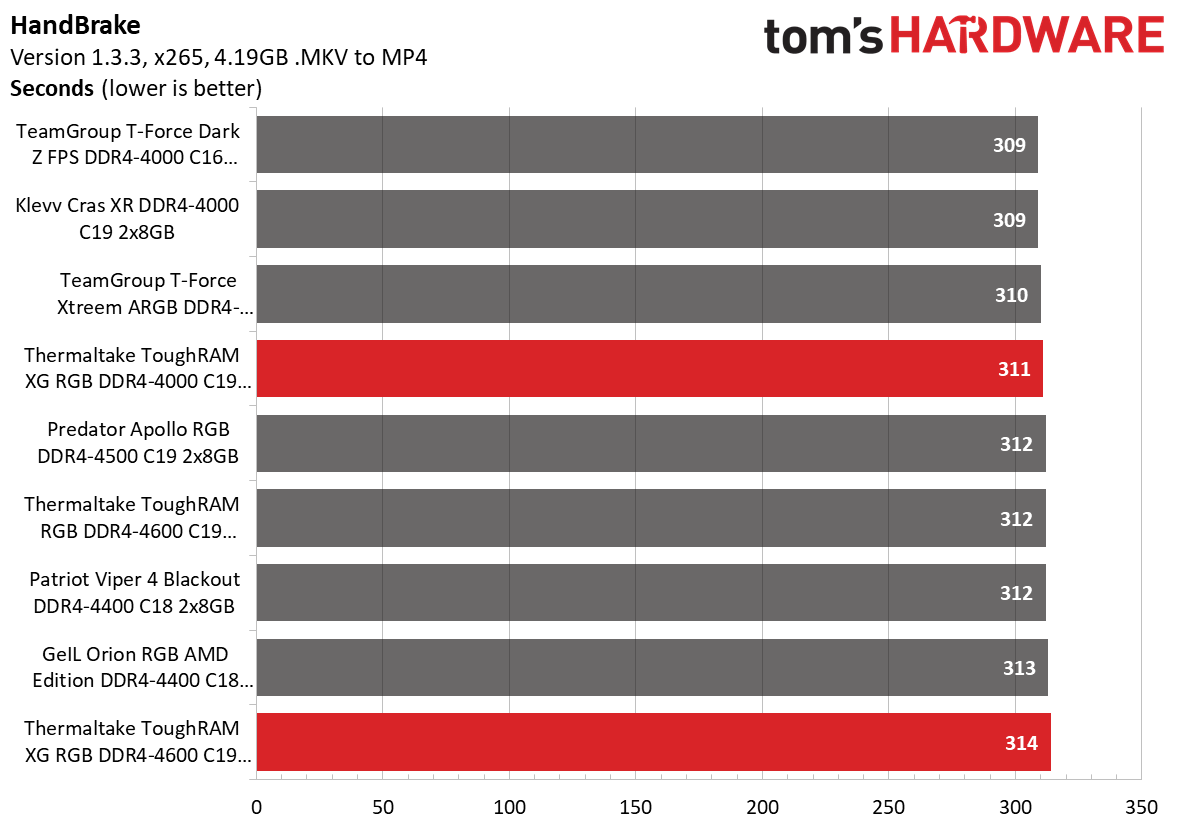
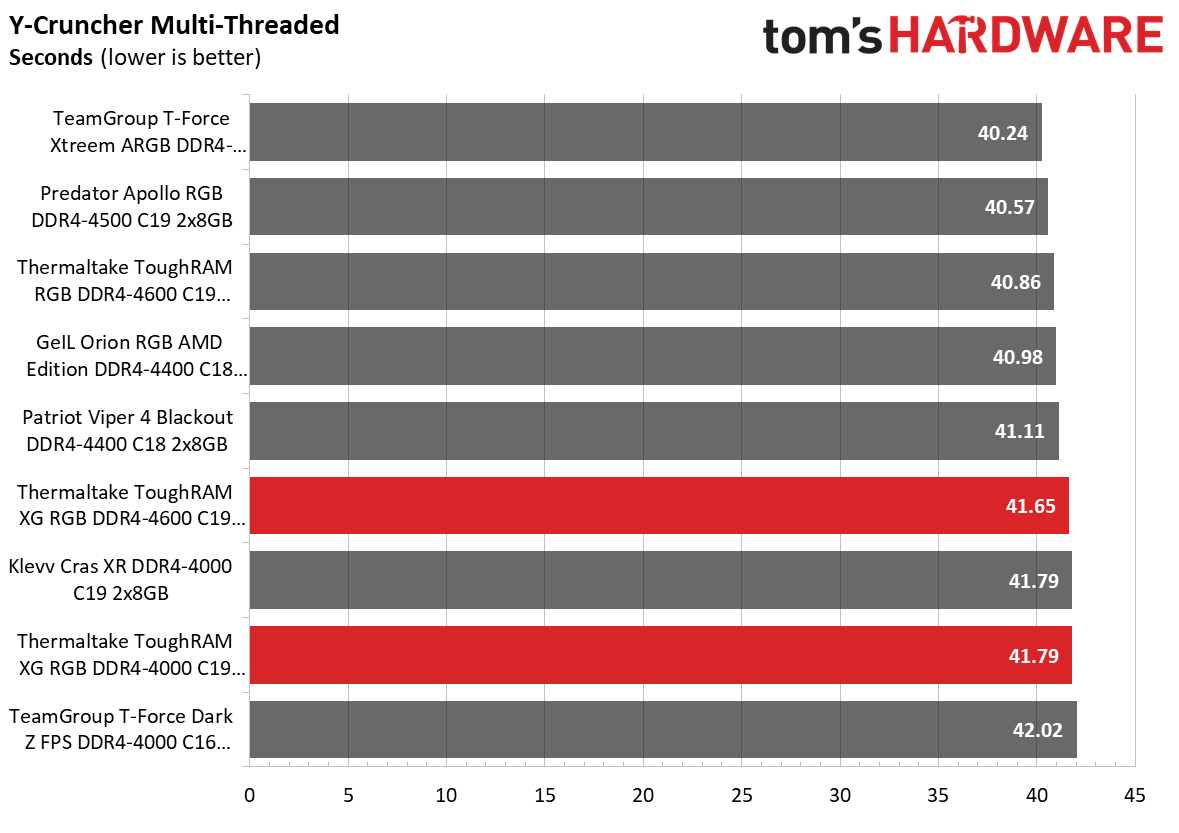

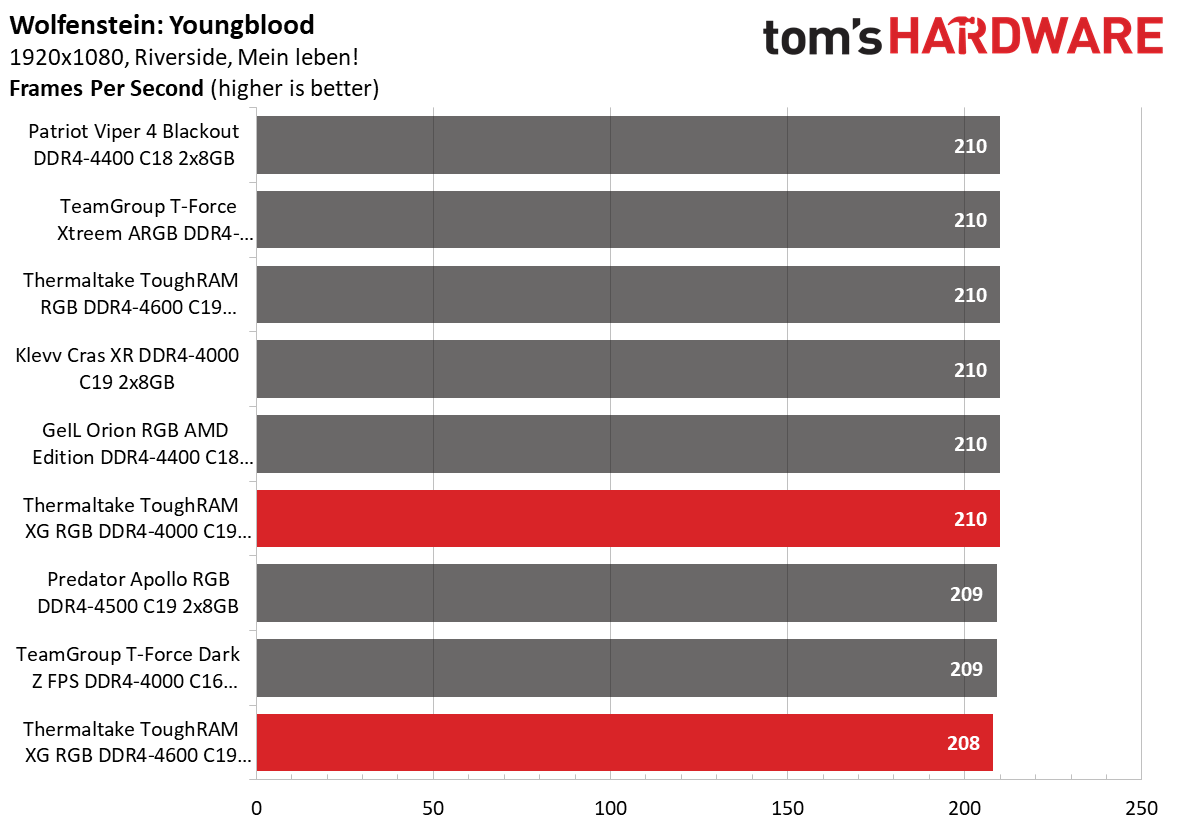

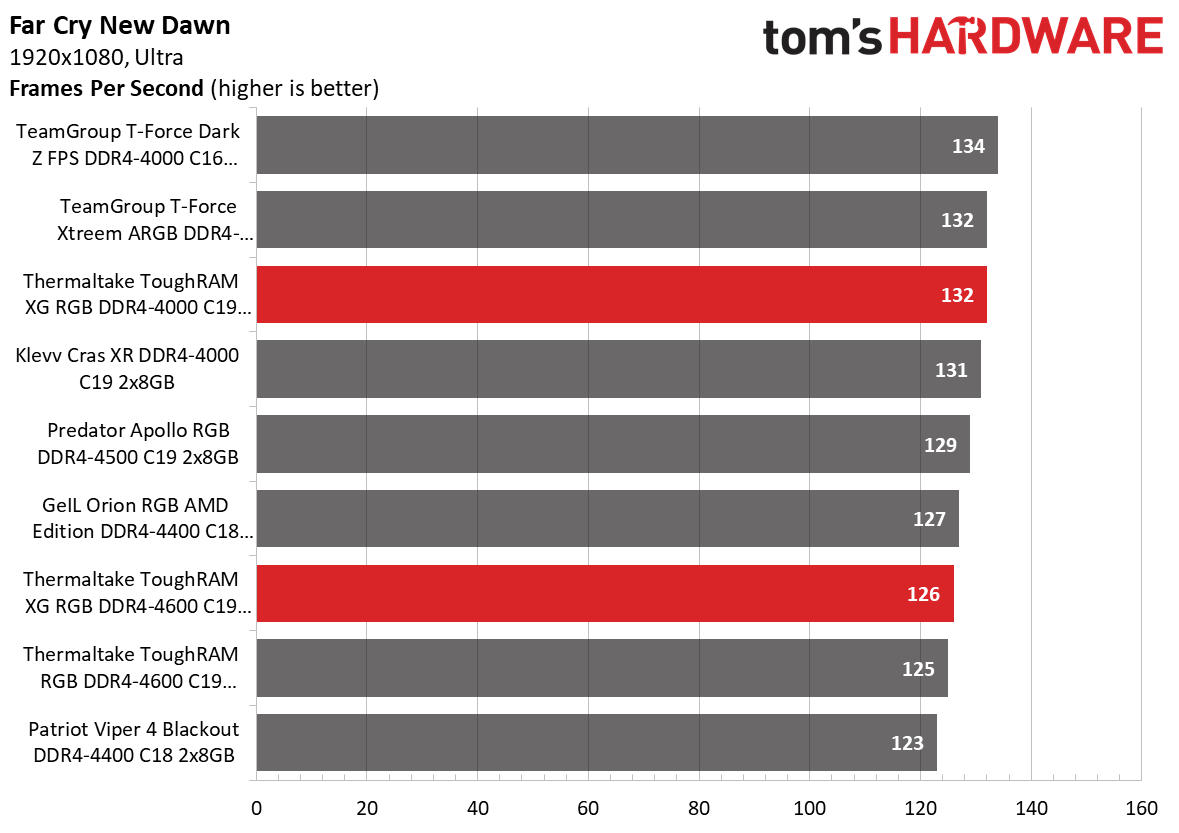
The DDR4-4000 memory kit separated itself from its sibling on the AMD platform in both application and gaming performance. Our Ryzen 9 5900X's maximum stable FCLK was 2,000 MHz, so it was able to take advantage of the DDR4-4000 without any latency penalty. For the DDR4-4600 memory kit, on the other hand, we had to run it at half the FCLK.
Overclocking and Latency Tuning

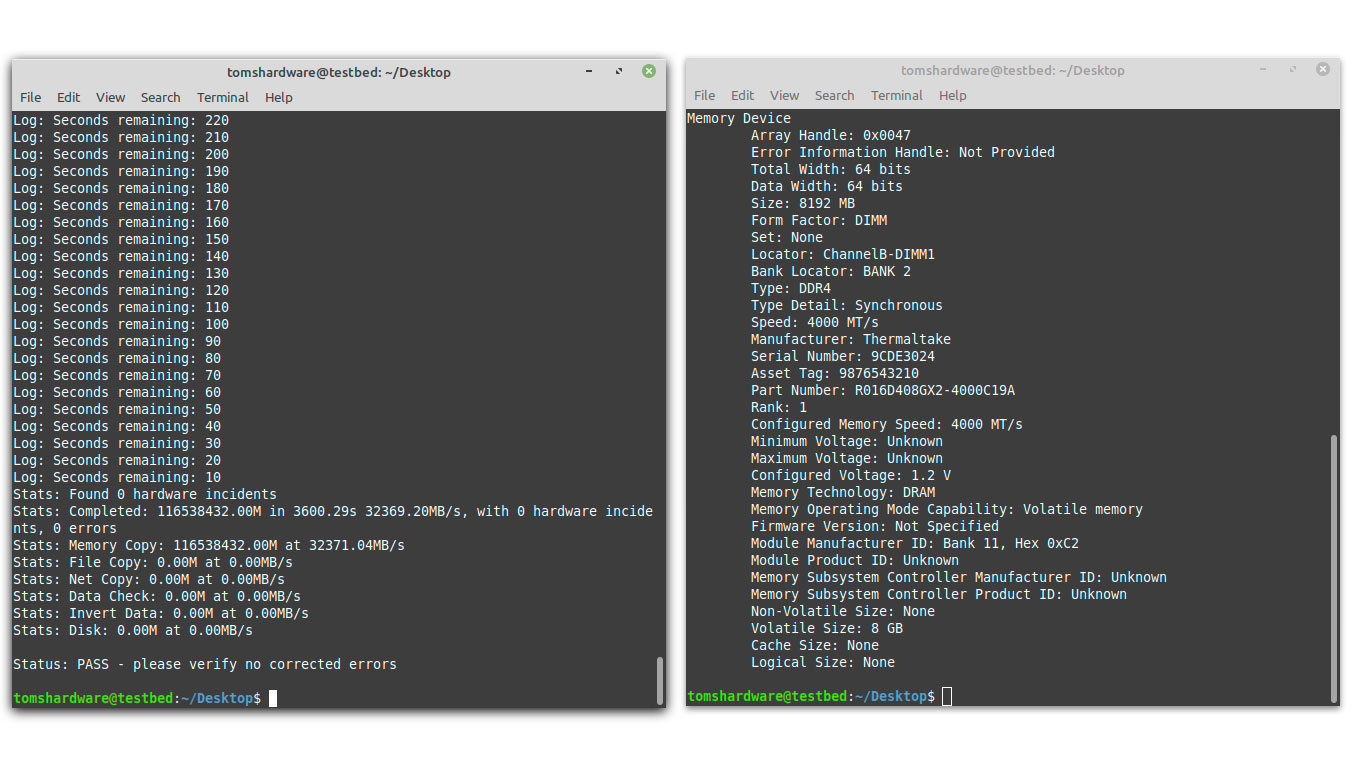
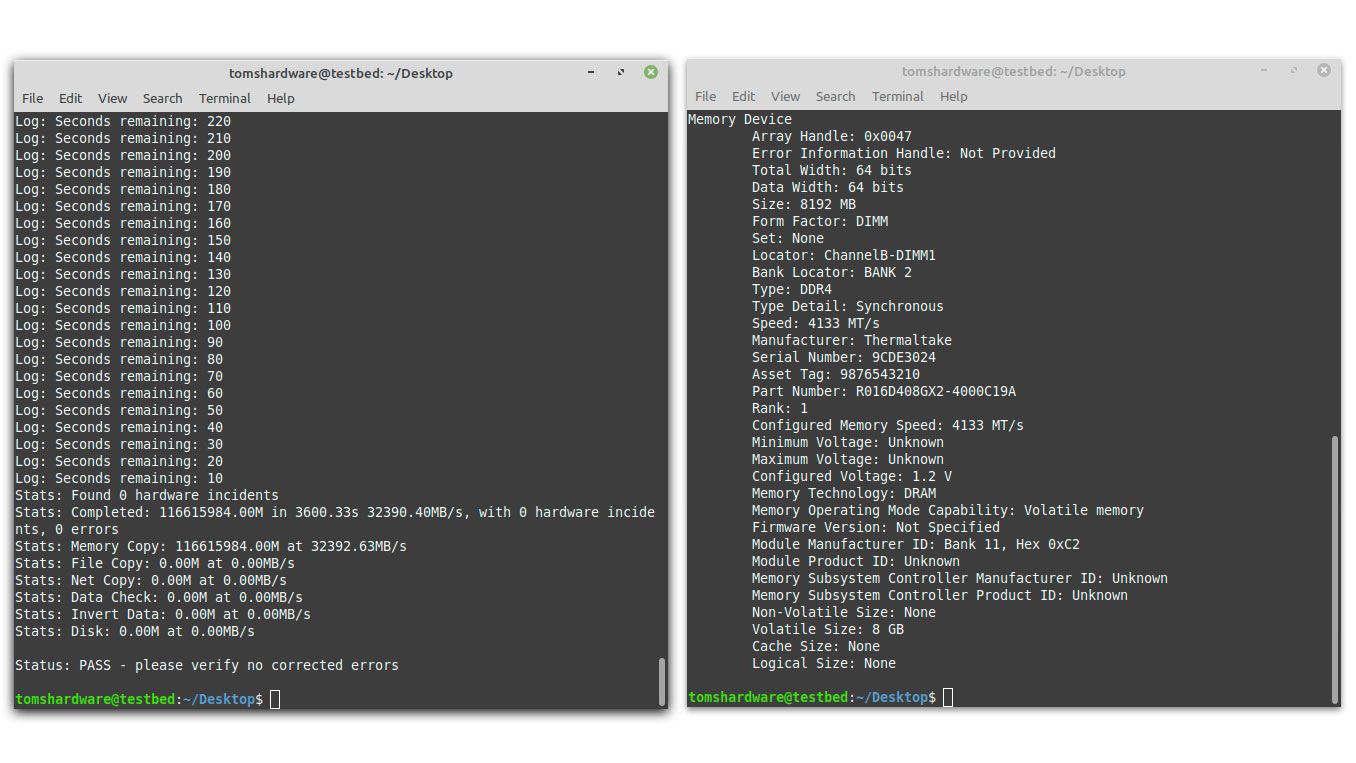
The ToughRAM XG RGB DDR4-4600 memory kit utilizes the same Hynix D-die ICs as the regular ToughRAM RGB DDR4-4600 memory kit that we previously reviewed. While we were able to push the latter to DDR4-4666, the XG variant simply wasn't cooperative. We even went as high as 1.6V on the DRAM voltage, but to no avail. It just goes to show that the quality of the ICs varies from one memory kit to another, even if they're from the same vendor and model.
On the contrary, the DDR4-4000 variant went to DDR4-4133 with ease. With the bump in the DRAM voltage to 1.45V, we even managed to retain CAS Latency 19 and drop the tRCD, tRP and tRAS from 26-26-45 to 23-23-43.
Lowest Stable Timings
| Memory Kit | DDR4-4000 (1.45V) | DDR4-4133 (1.45V) | DDR4-4000 (1.50V) | DDR4-4300 (1.50V) | DDR4-4400 (1.45V) | DDR4-4600 (1.55V) | DDR4-4666 (1.56V) |
|---|---|---|---|---|---|---|---|
| Thermaltake ToughRAM RGB DDR4-4600 C19 | N/A | N/A | N/A | N/A | N/A | 18-25-25-45 (2T) | 20-26-26-45 (2T) |
| Thermaltake ToughRAM XG RGB DDR4-4600 C19 | N/A | N/A | N/A | N/A | N/A | N/A | N/A |
| Klevv Cras XR DDR4-4000 C19 | 18-22-22-42 (2T) | N/A | N/A | N/A | 19-25-25-45 (2T) | N/A | N/A |
| TeamGroup T-Force Dark Z FPS DDR4-4000 C16 | N/A | N/A | 15-15-15-35 (2T) | 17-17-17-37 (2T) | N/A | N/A | N/A |
| Thermaltake ToughRAM XG RGB DDR4-4000 C19 | 17-22-22-42 (2T) | 19-23-23-43 (2T) | N/A | N/A | N/A | N/A | N/A |
The low quality of the Hynix D-die ICs in the ToughRAM XG DDR4-4600 memory modules didn't allow us to tighten the timings at DDR4-4600, either. Increasing the DRAM voltage to 1.6V did nothing for optimization. With the DDR4-4000 memory kit, however, we got the primary timings as low as 17-22-22-42 at 1.45V.
Bottom Line
Thermaltake's ToughRAM XG RGB lineup is basically a makeover of the brand's existing ToughRAM RGB product line. The new series arrives on the market with a new look that you might dig or not. Both memories are of similar height, so Thermaltake didn't really optimize the design on the XG variant for better CPU cooler compatibility or anything of that sort.
The ToughRAM XG RGB DDR4-4000 and DDR4-4600 C19 memory kits retail for $184.99 and $228.40, respectively. The pricing is competitive to comparable rivals, but do note that it includes the RGB tax, so there are cheaper but less flashy options out there. If you're not completely sold the ToughRAM XG RGB's revamped aesthetics, the vanilla ToughRAM RGB counterparts are also available with savings between $9 to $15, depending on the frequency. Between the DDR4-4000 and DDR4-4600 options, the first is the better choice, especially for Ryzen owners with a chip that can do 2,000 MHz on the FCLK.

Zhiye Liu is a news editor, memory reviewer, and SSD tester at Tom’s Hardware. Although he loves everything that’s hardware, he has a soft spot for CPUs, GPUs, and RAM.